#Also the background theme of gentrification
Explore tagged Tumblr posts
Text
red hood: the hill is literally giving me everything I could ask for in a Jason story we’ve got:
-Jason in a separate part of Gotham away from the bats
-Rhato original gothamite characters and villain
-Teaming up with and connecting with people he knew pre-Robin (Dana Harlowe my beloved)
like literally everything I could’ve asked for if it’s bad I’m killing myself in front of dc headquarters
#But the author has a decent track record so it’s probably going to be decent I HOPE AND PRAY#Also the background theme of gentrification? That could be very interesting depending on how it’s handled#I was excited for Gotham war (<- idiot) I can’t get burned again 🙈#Jason Todd#dc
27 notes
·
View notes
Text
A (Negative) Review of Tom Taylor's Nightwing Run - What Went Wrong? Bludhaven (PART 1)
Introduction Who is Dick Grayson? What Went Wrong? Dick's Characterization What Went Wrong? Barbara Gordon What Went Wrong? Bludhaven (Part 1, Part 2) What Went Wrong? Melinda Lin Grayson What Went Wrong? Bea Bennett What Went Wrong? Villains Conclusion Bibliography
Dick and Babs’ relationship also comes at the cost of something crucial: the citizens of Bludhaven.
Because Dick is often either with Babs or interacting with his other superhero connections, he does not engage with the people he is meant to protect. As a result, we as readers do not get to know the people of Bludhaven, much less grow to care for them. Bludhaven is barren. The only ones Dick interacts with are Babs, Titans, and occasionally Melinda. He is Bludhaven's protector but he has built no relationships with the people in his city.
When Dick’s apartment building blew up, Wally quite removed Dick from Bludhaven, robbing him of the opportunity to interact with his neighbors, with Clancy, or even his enemies. Having the Titans in Bludhaven further exacerbates this problem by creating a distance between Dick and the others in the city. Dick may be in Bludhaven, but he is not interacting with the people of Bludhaven. He literally lives in a tower removed from the rest of the population. Dick does not have a job of his own, we do not get to see him working for the Alfred Pennyworth Foundation, and because now he gets to be Nightwing more often, he is robbed of even more opportunities to experience a normal daily life in Bludhaven. By having Dick move into the Titan's tower, interact primarily with Babs and the Titans, and work solely as Nightwing, Taylor created a rift between Dick, his city, and its people.
As another Dick Grayson Fan put it in a discussion (From here on referred to as Dick Grayson Fan C):
“The problem [with the current iteration of Dick and Barbara’s relationship] has been there for years but what really brings it out in Taylor’s run - apart from DickBabs being attached at the hip - is that his Bludhaven is just very gentrified. It’s a reflection of the DickBabs relationship. And because Taylor can’t write more than one shallow plot, it’s the same for the Titans.”
Taylor’s Bludhaven is incredibly sanitized. It gestures at discussions of social justice without portraying them, it creates a simplistic black-and-white morality system that does not require the reader to be uncomfortable with the difficult realities of our world. The way Dick Grayson Fan C united both the Dick and Barbara romance and the portrayal of Bludhaven under the term “gentrification” perfectly captures how the relationship undermines the themes the story claims to care about.
Taylor’s Bludhaven has always been sanitized, but when the Titans show up, they displace Bludhaven citizens (literally moving into their neighborhoods, and figuratively by taking up the space Bludhaven citizens should have in a Nightwing story). Their relationship to Dick gentrifies the city and the story, making it so everything appears “nicer” and so Dick does not have to interact with the messier, more uncomfortable aspects of Bludhaven. He only gets to engage with those who are pristine, who share the exact same worldview as him, those affluent and privileged enough to dedicate their lives to superhero-ing without having to worry about being rent, paying bills, caring for their family, the stresses of a job, and any other problems.
For a world that is supposedly diverse, Dick only gets to have meaningful interactions with those whose heroic background and opinions on issues completely align with his own.
The Alfred Pennyworth Foundation would have been the perfect vehicle through which Bludhaven could have been fleshed out and Dick could have contributed to the care of his city while not being a vigilante. Yet, because Taylor tends to avoid conflict and makes it so everything must come easy to Dick, we are robbed of opportunities for Dick to grow, for the city to be fleshed out, and for the themes Taylor claims to care about to be fully explored.
Think about it: What reason do the people of Bludhaven have to believe that Gotham-native and newly billionaire Dick would keep his promise to create a shelter for their homeless youth population? Why should they believe that he is different from the other politicians or so-called philanthropists that took advantage of the system and of Bludhaven’s people in order to line their own pockets? And even if Dick was genuine in his efforts, why should they believe Dick would succeed when Blockbuster has the entire city under his thumb?
Dick never has to work to gain the trust of the citizens of Bludhaven. Because we are robbed of this conflict — that of Dick wanting people to trust him and people being reluctant to do so due to their past experiences — we are also robbed of a story that shows rather than tells the problems Dick tries to solve while also creating rich interactions between our protagonist and the people of his city. A conflict in which Dick has to prove himself to be trustworthy would have also given us the opportunity to meet and care for actual Bludhaven citizens, seeing them as individuals with diverse backgrounds, values, and personalities rather than a blank faceless mass.
Not only would a conflict in these early stages of Haven’s creation serve to develop Dick’s character, flesh out Bludhaven as a city with its own unique personality and problems, and create a side cast filled with individuals, but it would also work towards the main themes of the story. By denying us of said conflict, Taylor in turn makes his story weaker while undermining the thesis of his work.
On a bureaucratic front, Dick also faces no challenges. He never has to work to get his foundation started. After his announcement, we do not get to see him taking any of the practical steps required to run a nonprofit foundation and getting started on such a project. Furthermore, any bureaucratic challenges he should have faced given how the source of Bludhaven’s troubles are one of corruption, are easily waved away by Bea who later takes credit for this smooth ride, robbing Dick of agency and of his own accomplishments. Though Dick refused to acknowledge her work even as he received recognition for helping Bludhaven #113.
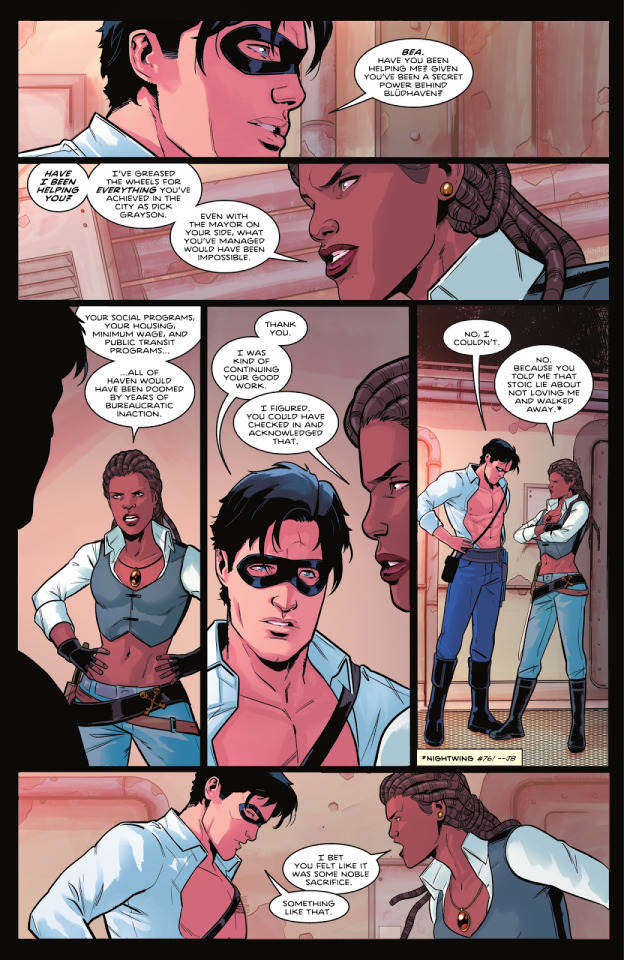
(Taylor, Tom, writer. Byrne, Stephen, illustrator. The Crew of the Crossed Part Three. Nightwing: Rebirth. 107, e-book ed. DC Comics, 2023. pp. 06)
Ordinarily, I wouldn’t consider that to be much of a problem. After all, the reason why Detective Comics and Batman comics do not focus on Bruce’s philanthropy is because that is not the focus of those stories (Though I once more feel the urge to note that Cataclysm and No Man’s Land managed to incorporate such elements into the main plot while still keeping the focus on the gang wars, superhero work, and detective investigation). But Taylor made The Alfred Foundation and Haven a centerpiece of the beginning of his run. In his attempts to address the popular online discourse about Bruce’s money being a solution to Gotham’s problem, Taylor made the idea that Bludhaven needed Dick Grayson’s philanthropic efforts to be their safety net a main theme of his story. For that reason, this plot element should have been a major focus, which means it should have been a main source of conflict in ways that showed just how Blockbuster’s cruelty affected the disposition of Bludhaven’s citizens.
The absence of conflict and tension in the story point that is so pivotal to Taylor’s run demonstrates not only Taylor's underwhelming abilities as a writer, but also how he approaches writing not with a focus on storytelling, but rather with a focus on online discourse. Scholar Steve Braxi highlights this as one of the main problems in Taylor’s writing when examining both Nightwing and Superman: Son of Kal-El in the essay On Superman, Shootings, and Realities of Superheroes. There, Braxi dismantles criticisms against the “socio-political” responsibilities of fictional superheroes by arguing such critiques to be in bad-faith for demanding “political solutions from fictional realities.” According to him, in these arguments, “Superman and Batman are not treated here as ideas readers want to believe in, but rather people that need to prove their worth to us. They need to take on real issues in their fictional world in order for their fictional solutions to speak to our real world. This equivalency between their world and ours has a dissonant effect on me because I think it misunderstands the entry point of fiction in the first place.” (Braxi, Steve, “On Superman, Shootings, and the Reality of Superheroes” Comics Bookcase, September 2021)
Taylor’s decision to make Dick a billionaire who uses his money for the social benefit of others is a response to popular online discourse about whether Bruce Wayne should use his money to help Gotham in ways other than Batman. While I already pointed out that such arguments ignore the fact that Bruce does, canonically, use his wealth to the benefit of others, Braxi points out that “the argument that Superman ignores real social issues or that Batman is worse than the crime he fights does not assume the best intentions of the characters, creators or nature of fiction. They engage with these stories from a perspective that is intentionally distant from the unique reality of the story being told.” (Braxi, Steve, “On Superman, Shootings, and the Reality of Superheroes” Comics Bookcase, September 2021)
Braxi rightfully argues that attempts to respond to shallow criticism leads to shallow storytelling. It is only because these are popular online arguments that Taylor makes them important plot points in his story. And yet, despite their supposed importance, the Alfred Pennyworth Foundation and Haven are not properly incorporated into the story because Taylor does not take into consideration what these elements say about his characters, his themes, and how they can shape the plot on a deeper level. As such, the lack of meaningful conflict can be seen as a symptom of this thoughtlessly performative desire to play into trendy discourse. Character complexity, narrative depth, and thematic cohesion are all sacrificed to please an ever changing social media algorithm and debates that are forgotten and disregarded in a matter of days.
Even the Alfred Pennyworth Foundation’s name is, quite frankly, evidence of such online fan pandering at the cost of characterization and narrative. Alfred is beloved by many, and while we do not have time to discuss DC’s attempts to sanitize his character after his death (While I adore Alfred, he had many flaws that affected the manner in which he raised Bruce and Dick. These flaws, however, have been ignored or erased by current comics that prefer to portray Alfred as a benevolent father figure who never made any mistakes. While I believe Bruce and Dick would glorify Alfred in such a manner, that does not mean the narrative has to agree with their biased perspectives),
the reality is that though Alfred may mean a lot to Dick Grayson fans, he means nothing to the people of Bludhaven. From my personal point of view, Alfred was also not the type of person who would have liked to have a statue in his honor in a city he never visited. From an in-universe perspective, naming a nonprofit meant to help the people of Bludhaven after a man who did not even live in their city and then erecting a statue in his honor makes no narrative sense. But Taylor does it because the statue means something to the audience, regardless of how that would play in-universe.
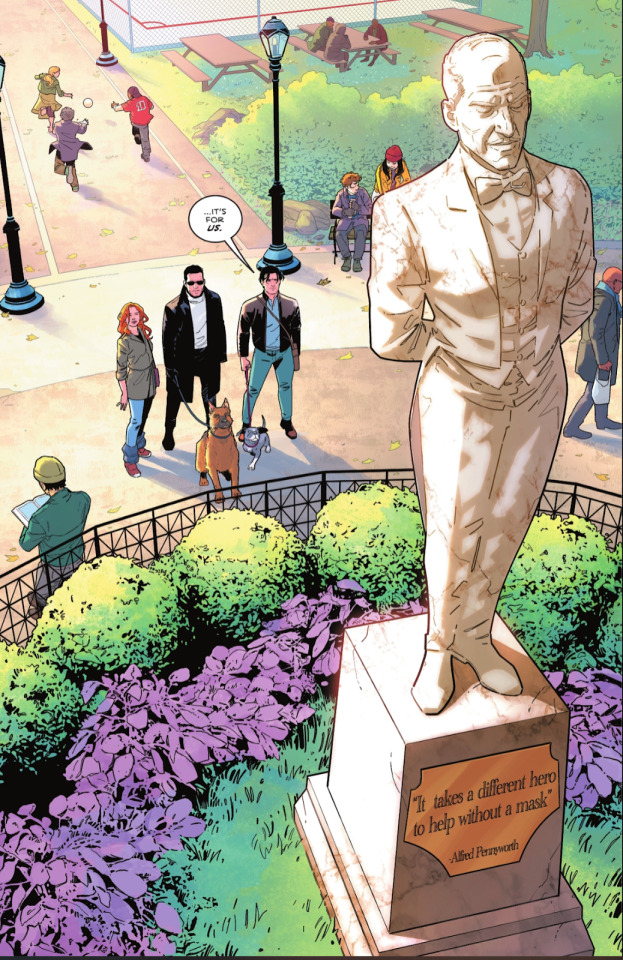
(Taylor, Tom, writer. Redondo, Bruno, illustrator. The Battle for Bludhaven’s Heart. Nightwing: Rebirth. 92, e-book ed. DC Comics, 2022. pp 12)
Furthermore, by not having Dick interact with the people of his city, Taylor contradicts his supposed characterization of Dick as a “good guy.” This is yet another instance of telling and not showing, and it is most obvious when looking at Heartless.
Though Taylor tried to build up Heartless as this intimidating villain, he put little effort into matching said intimidation with the appropriate amount of urgency. Dick does not treat Heartless as an actual threat. This, as mentioned previously, transforms Dick into a self-absorbed man who does not understand (or does not care) about dangers being posed to the people of his city.
From both a narrative and a character standpoint, the fact that the children of Heartless’ victims mirror Dick’s own experience makes this disconnect even more frustrating.
Dick lost his parents. He knows what it feels like to see their dead, bloody bodies on the floor when you’re but a small child. Dick also knows how finding justice can help with closure, and how not finding justice can haunt you for the rest of your life. Knowing that Heartless made countless kids into orphans should be a crucial motivation for Dick to fall into that intense and obsessive pursuit that characterizes his crime fighting. Dick should be working on this case constantly, for he knows what those kids are going through. Dick appointed himself their protector, yet he does nothing for them. He does not guide them through their grief the way Bruce did for him, he does not find justice for their parents the way Batman and Robin did when they captured Zucco, he does not offer them closure or an outlet for their anger and their pain. The story does not show Dick to be a hero, but rather, it makes him into an incredibly selfish, lazy person who is only interested in the optics of heroism, and not the, often thankless and unacknowledged, work it takes to actually help people.
The contrast between how Dick is Nightwing: The Untouchable and Taylor’s run could not be greater. The former carried every death on his shoulders, determined to push through bullet wounds in order to prevent more killings. The latter behaves as if Heartless did not exist unless he is on screen.
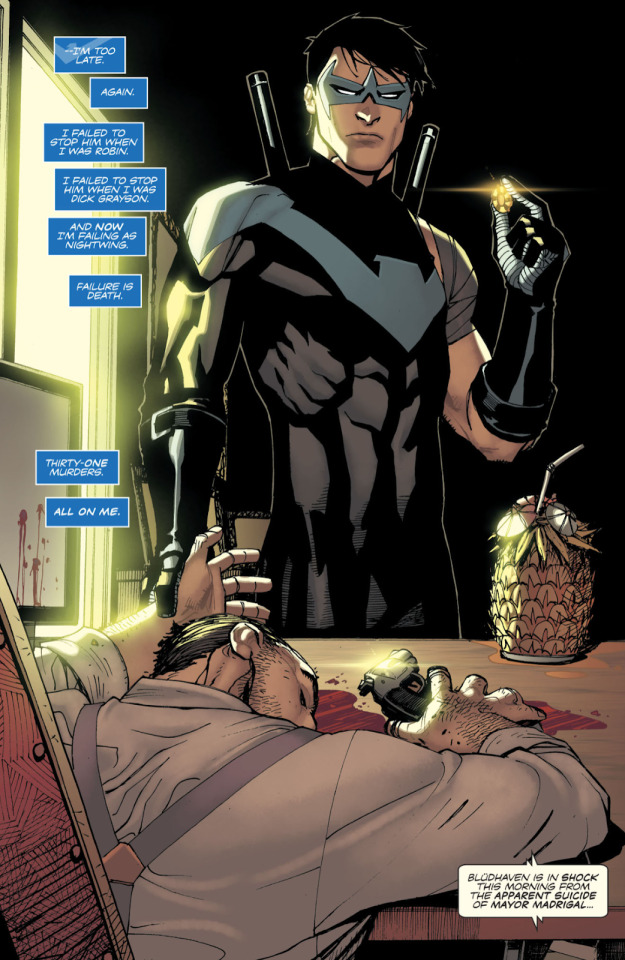
(Humphries, Sam, writer. Chang, Bernard, illustrator. The Untouchable: Chapter Two: Relentless. Nightwing: Rebirth no. 36, e-book ed. DC Comics, 2018. Page 20)
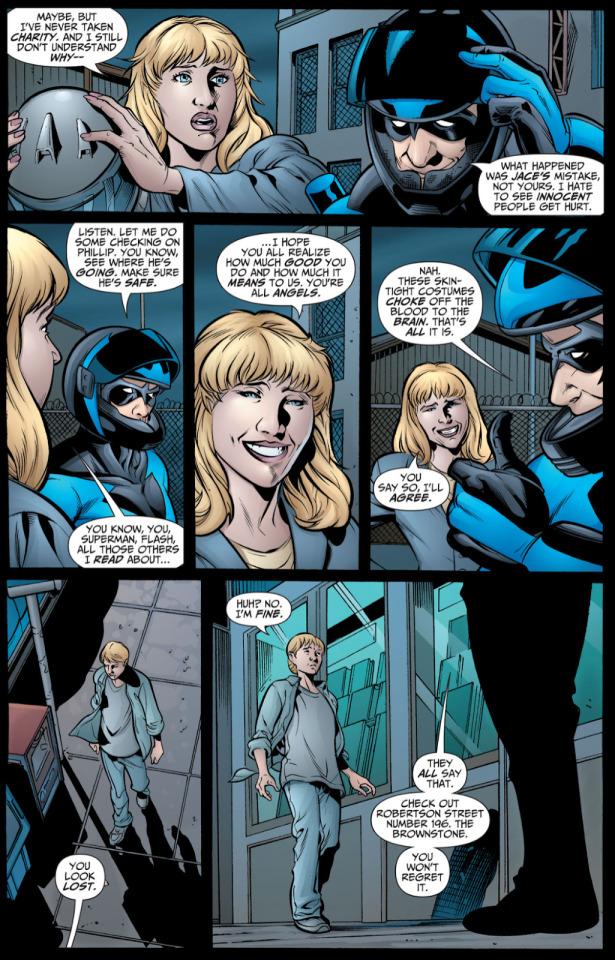
(Wolfman, Marv, writer. Igle, Jamal, illustrator. Bride and Groom: Part One: The Courtship. Nightwing no. 129, e-book ed. DC Comics, 2007. pp. 11)
That is because Wolfman understood that the best way to show Dick’s compassion was to have him interact with those whose lives were made better by his presence. As readers, we were able to experience first-hand the difference Dick makes on an individual and personal level. This is more than just having Nightwing appear in a pencil case; this shows Dick actively interacting with the people of his city, forming genuine connections with them, and putting in the work to make their lives better because he cares.

(Wolfman, Marv, writer. Luque, Paco Diaz, illustrator. Bride and Groom: Part Four. Nightwing no. 132, e-book ed. DC Comics, 2007. pp. 24)
Please understand that I am not saying that Heartless should be present in every single issue, from the moment he was introduced to the moment he is finally caught. But just because he is not physically there, it does not mean that the story should not be exploring the effect his actions have on his victims' loved ones. Readers should see the terror that grips Bludhaven as a serial killer is on the loose. How do people, especially the homeless youth Dick vowed to protect, react when they don't feel safe? Heartless doesn't need to be physically there, but his presence and its effect should still be felt. That's what happened with Blockbuster in Nightwing (1996) – he may not have been there all the time, but his grip on Bludhaven, on the corrupt systems, on Dick's life, was still always present.
By depicting Heartless’ effect on Bludhaven would not only add urgency and stakes to the plot, it would give faces to his victims while giving Dick the opportunity to bond with the people of Bludhaven. Perhaps as Heartless’ orphans come together in their grief and anger, and once they realize that the corrupt BCPD isn’t going to bring justice to their parents, they decide to take matters into their own hands. Then Nightwing could step up and prevent them from going too far. He could teach them productive ways to channel their anger, give them shelter and an empathetic ear, and he would vow to do right by them when no one else did before. This would show Nightwing’s love for Bludhaven and it would bring the themes of inequality and social justice that Taylor claims to want to explore into the narrative in a more emotionally effective manner, for the homeless youth would have names, faces, and their own voices.
There doesn’t even need to be many children. In fact, there could be just one — Elliot, from #79.
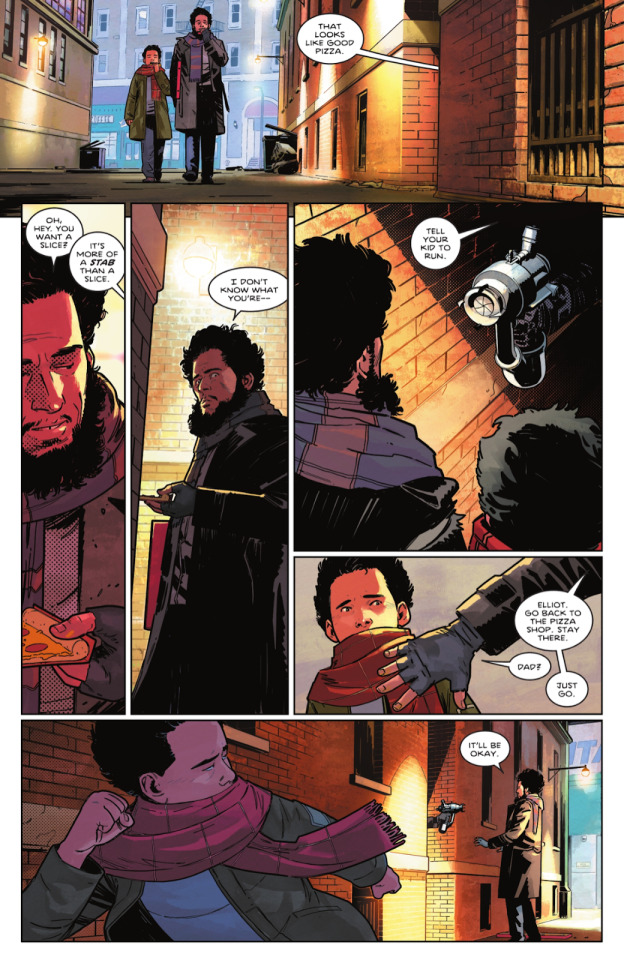
(Taylor, Tom, writer. Redondo, Bruno, illustrator. Leaping into the Light Part Two. Nightwing: Rebirth. 79, e-book ed. DC Comics, 2021. pp 11)
By making Elliot the face of Heartless’ true evil, the face of the victims of Bludhaven’s corrupt system, of people’s lack of compassion, Taylor would show the reader everything Dick wants to fix in Bludhaven and why it needs fixing. Elliot would humanize these abstract concepts so that the reader is emotionally invested in Dick’s success. The stakes are suddenly personal. Furthermore, it would prevent the city from feeling so barren while giving Dick people to care for outside of his already established connections. Just as Bruce did with him, Dick could see much of himself in Elliot, and that would lead him to want to help Elliot in a similar way Bruce helped him all those years ago. This also would have contributed to making the hug in #100 more effective, as it would be creating mirrors and parallels between Bruce and Dick’s relationship, and Dick’s relationship to Elliot.
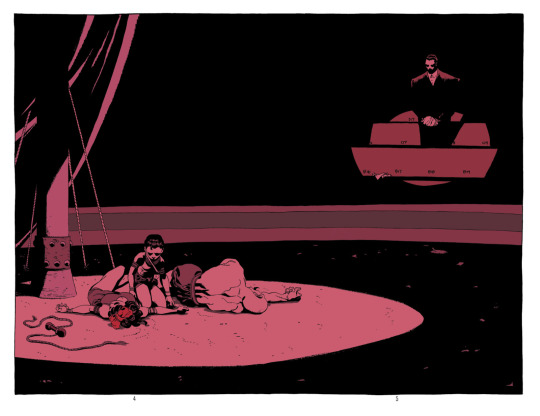
(Loeb, Jeph, writer. Sale, Tim, illustrator. Orphans. Batman: Dark Victory. 09, e-book ed. DC Comics, 2000. pp 05)
The fact that it took over thirty issues for Taylor to finally, finally, draw a connection between Bruce, Dick, and Heartless victims in #111 is, frankly, lazy and thoughtless.
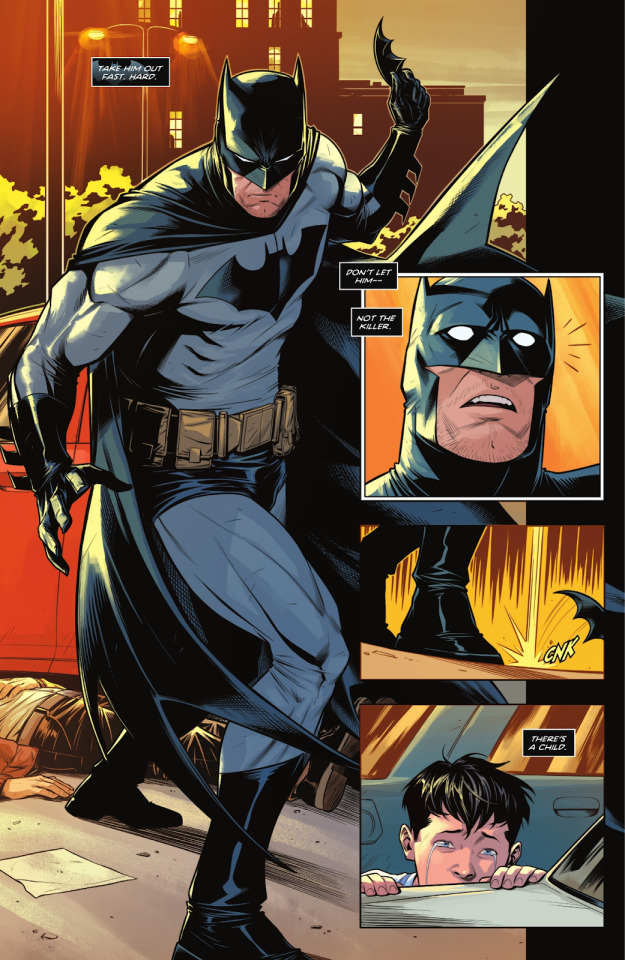

(Taylor, Tom, writer. Basri, Sami, illustrator. Nightwing. Nightwing:Rebirth. 111, e-book ed. DC Comics, 2024. pp 05-06)
In his 2022 video titled The Secret Ingredient That Makes Raimi's SPIDER-MAN So Great (Season Premiere), video-essayist and film critic Patrick H Willems discusses how vital of a role the ordinary citizen characters played in the Sam Sami Spider-Man trilogy. He describes how “they make the New York of these movies feel like a real, thriving city populated by a vibrant community of characters. Because if we’re going to care about Spider-Man caring about the people of New York, we have to actually get to know the people of New York.” (Willems, Patrick H. “The Secret Ingredient That Makes Raimi's SPIDER-MAN So Great (Season Premiere)” Youtube, uploaded by Patrick (H) Willems, 20 September 2022 https://www.youtube.com/watch?v=xFpQBOopf84)
Similarly, giving Bludhaven citizens, giving Heartless’ victims agency and individuality would have elevated the story and made Dick into a more empathetic and endearing hero. We would have cared about the people of Bludhaven because we would have gotten to know them through their interactions with Dick.
But to accomplish that, Taylor would have to actually care about who Dick Grayson is and who the people of Bludhaven are; he would need to actually care about the story he is trying to tell as a whole, rather than simply writing for moments that will merely appear progressive when removed from their context and presented on social media.
To be perfectly fair to Taylor and Redondo, they are hardly the only ones to miss an opportunity when it comes to Bludhaven. Even Dixon and Grayson, the first two who were given the chance to breathe life into this city, were satisfied to treat Nightwing’s abode as merely “Gotham lite.” In fact, much could be said about DC’s handling of Bludhaven, its lack of investment in the city, the ways in which it tried to erase it from its history, and what parallels can be made with how many in DC view Dick Grayson. What sets Taylor and Redondo’s mishandling apart from all others was that, instead of depicting Bludhaven as a generic corrupt city, they opted instead for a gentrified, picturesque liberal urban utopia. As Taylor’s Nightwing perfectly said when confronting Blockbuster, Roland Desmond is the one big identifiable bad guy who is shown to be the source of all of Bludhaven’s problems.
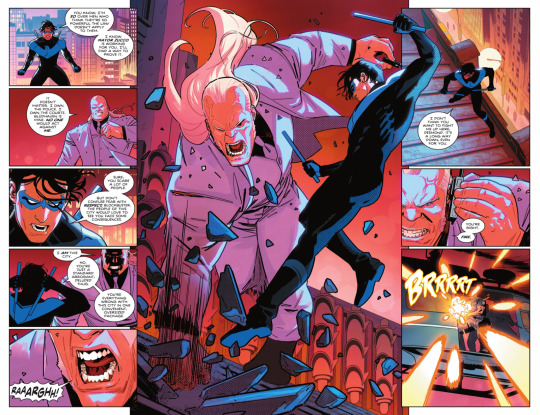
(Taylor, Tom, writer. Redondo, Bruno, illustrator Leaping into the Light Part Six. Nightwing: Rebirth. 83, e-book ed. DC Comics, 2021. pp. 08)
Like Gotham, Bludhaven is broken in a myriad of ways. While many of their problems come from those on top, both cities also face mundane evils that rise from not just suffering, but apathy. There are many stories about Gotham that explore the dark and the light side of humanity, acknowledging that both of them can be found in us. It was a small evil that killed Thomas and Martha, but it is a grander, structural evil that prevents justice from being served and hinders Gotham from prospering. It was also a grander, structural evil and corruption that put Joe Chill in a position where he held a family at gunpoint and murdered a mother and father in front of their young child.
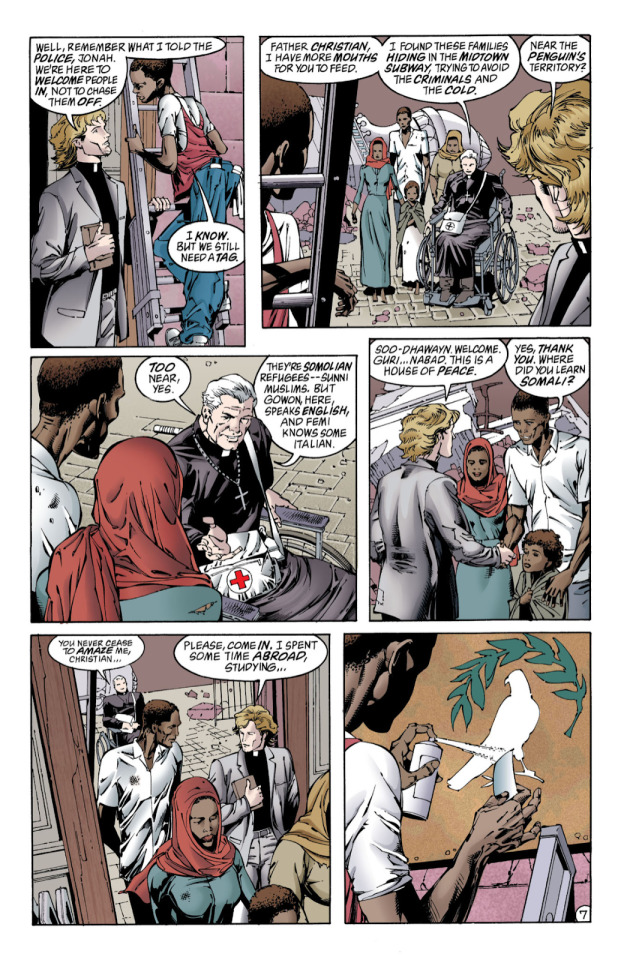
(Grayson, Devin, writer. Eaglesham, Dale, illustrator. Fear of Flames Part One: Fanning the Flames. Batman: Legends of the Dark Knight. 116, e-book ed. DC Comics, 1999. pp. 07)
Bludhaven is often characterized as Gotham’s little sister. In fact, it was the fact that the city reminded Dick so much of a Gotham without a Batman or a Gordon that Dick decided to take on the challenge of caring for Bludhaven. He saw a city in need, knew he could do something to help it, and so he did.
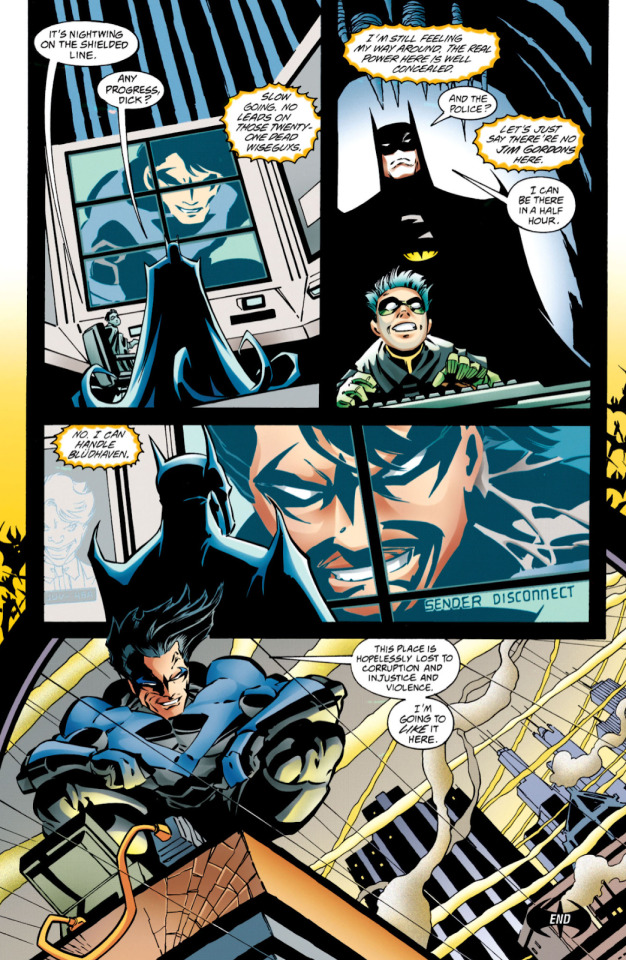
(Dixon, Chuck, writer. McDaniel, Scott, illustrator The Freebooters. Nightwing. 03, e-book ed. DC Comics, 1996. pp. 23)
Just Batman struggles in No Man’s Land when there is no system to uphold, the beginning of Dixon’s run is characterized by Dick struggling with the lack of allies or of a network in which he could trust. As Tim pointed out to him in Nightwing #06, Dick was all on his own.
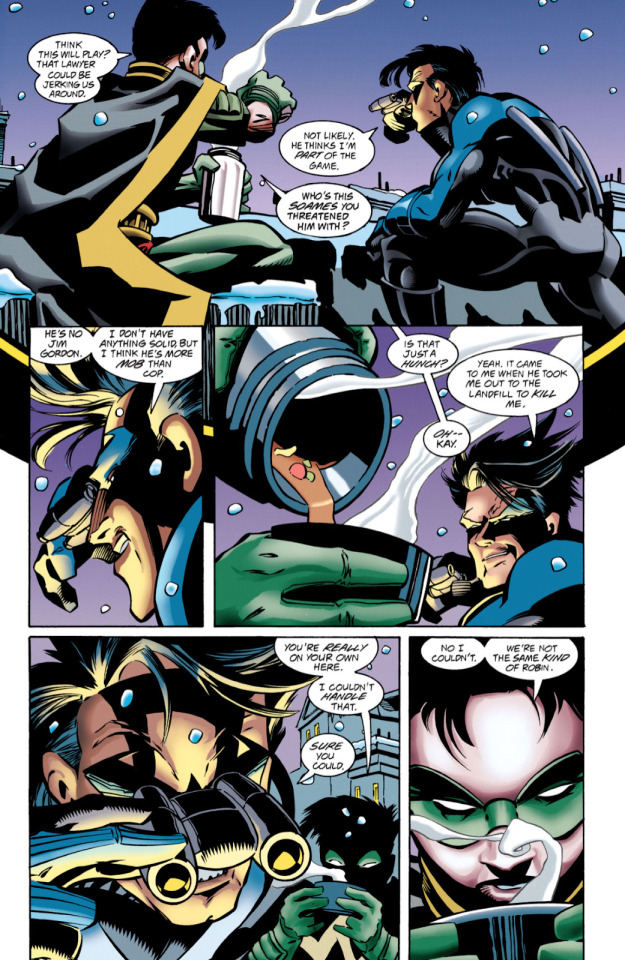
(Dixon, Chuck, writer. McDaniel, Scott, illustrator The Visitor. Nightwing. 06, e-book ed. DC Comics, 1996. pp. 12)
Tim Seeley also emphasized this isolation in his run, though in this scenario, Dick purposefully sought out this separation in hopes that being in Bludhaven would help him discover who he is.
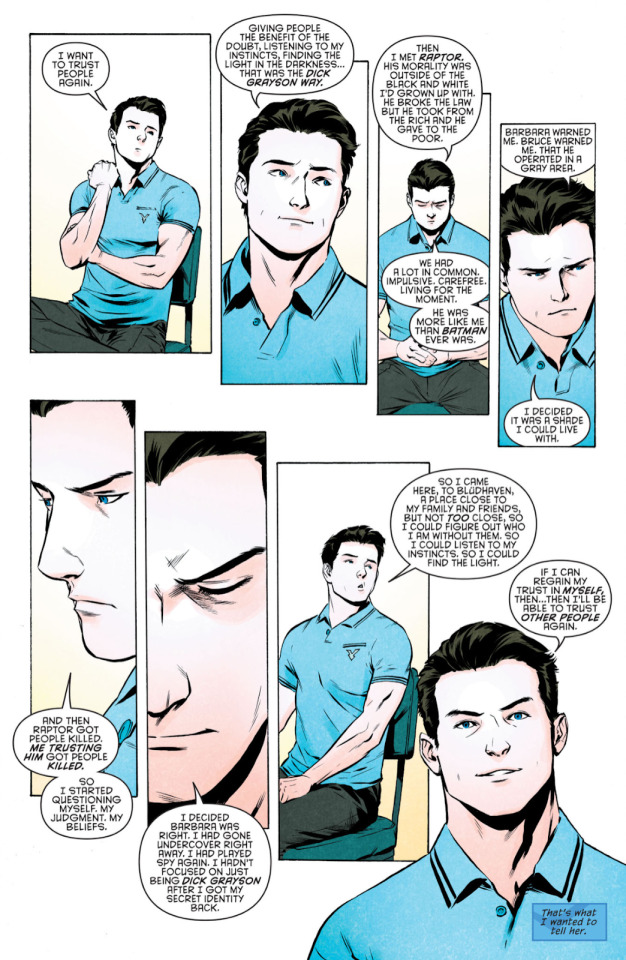
(Seeley, Tim, writer. To, Marcus, illustrator Bludhaven: Part One. Nightwing: Rebirth. 10, e-book ed. DC Comics, 2016. pp. 08)
As both runs progress, Dick slowly builds his own network of alliances. In Dixon’s run, which seems to be the one that, given Blockbuster’s presence, most inspired Taylor, Dick learns how the city operates and crafts a strategy that balances tackling emergencies, disrupting the system, and slowly untangling the messy rot beneath without causing unforeseen negative consequences.While Dixon’s run is filled with problematic elements in its own right (especially when it comes to the portrayal of women and even some aspects of Dick’s characterization), this section will be focusing on how the narrative provides opportunities for Dick to interact with the ordinary people of Bludhaven. (Taylor drawing inspiration from Dixon’s run can be observed not only on the similarities between the plot points [though he retreads mainly Grayson’s run rather than Dixon’s], but also by Taylor’s own admission. In February 2024, when Dixon posted a homophobic tweet about Jon Kent and Dick Grayson, Taylor expressed his disappointment over Dixon’s attitude and cited how Dixon’s run was an inspiration to him.)
Clancy becomes a bridge between Dick and his neighbors, who represent different facets of Bludhaven.
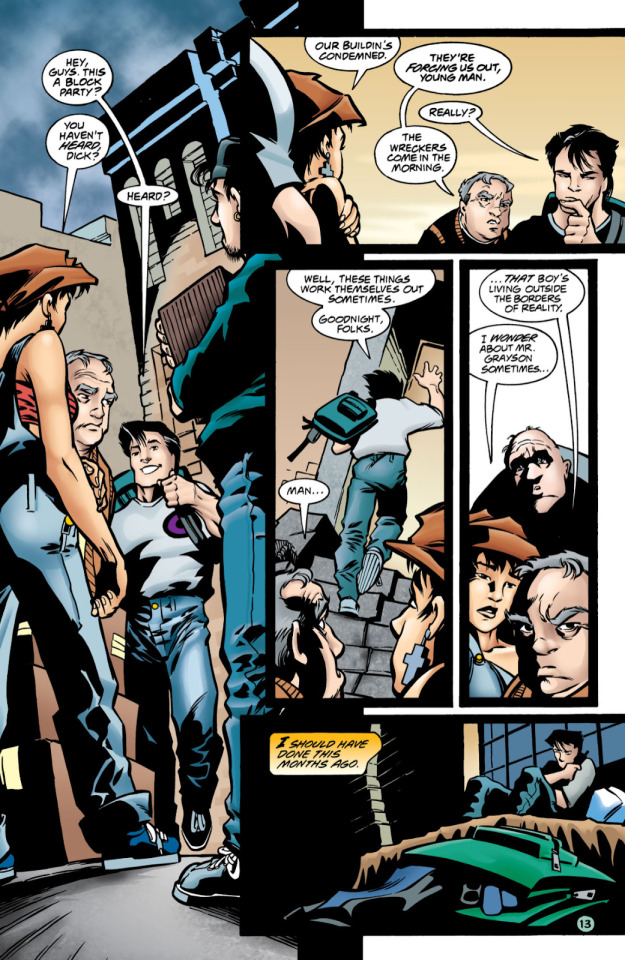
(Dixon, Chuck, writer. McDaniel, Scott, illustrator. False Starts. Nightwing. 21, e-book ed. DC Comics, 1998. pp. 13)
Through his work as a bartender he gains insight into cold cases, learns more about the Bludhaven City Police Department.
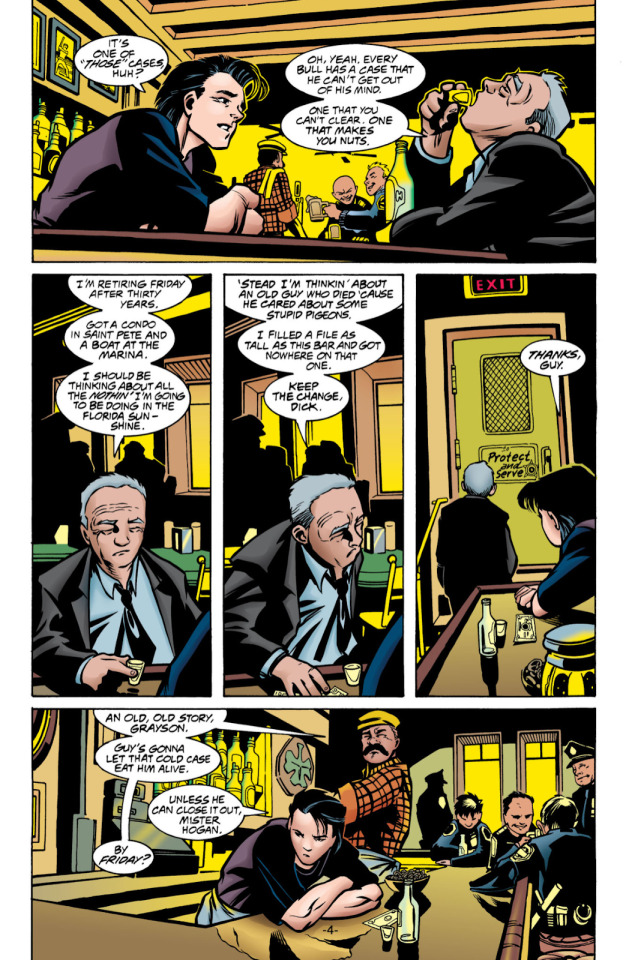
(Dixon, Chuck, writer. McDaniel, Scott The Forgotten Dead. Nightwing. 24, e-book ed. DC Comics, 1998. pp. 24)
He befriends his partner Amy Rohrbach, and with her, he learns about the small alliance of clean cops that are trying to overthrow the current dirty officials.
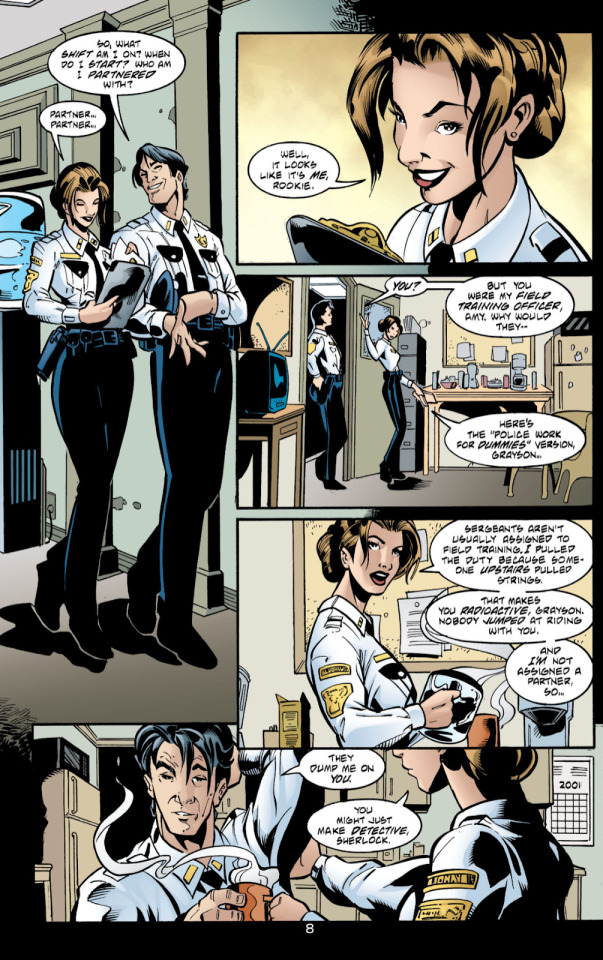
(Dixon, Chuck, writer. McCarthy, Trevor, illustrator. The Threshold. Nightwing. 60, e-book ed. DC Comics, 2001. pp 08)
Similarly, Grayson's run shows us the complicated politics of the city’s underworld, presenting the reader with a myriad of characters. While Dick certainly encounters greedy mobsters interested only in using violence as a means to gain wealth
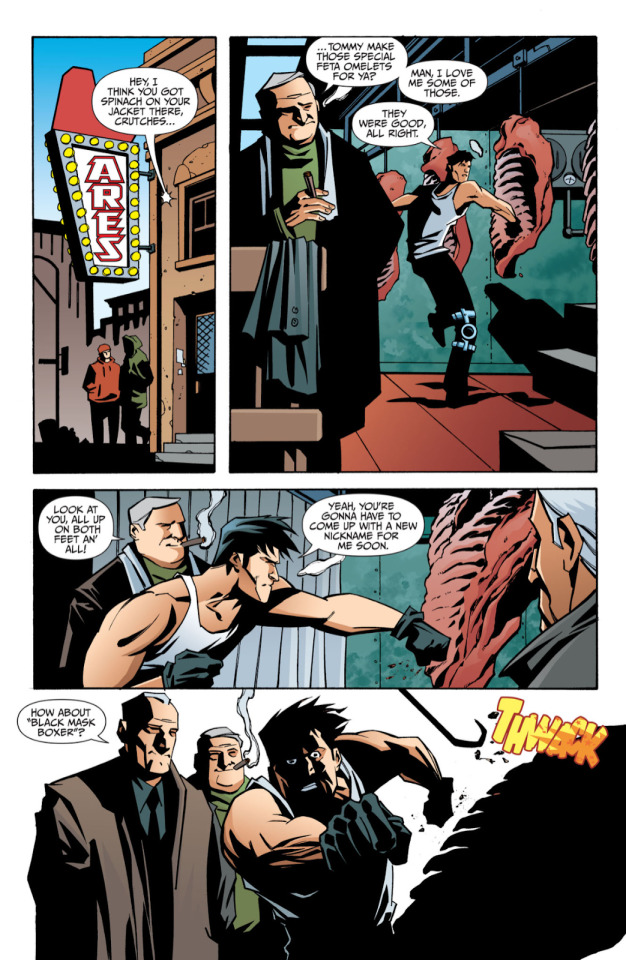
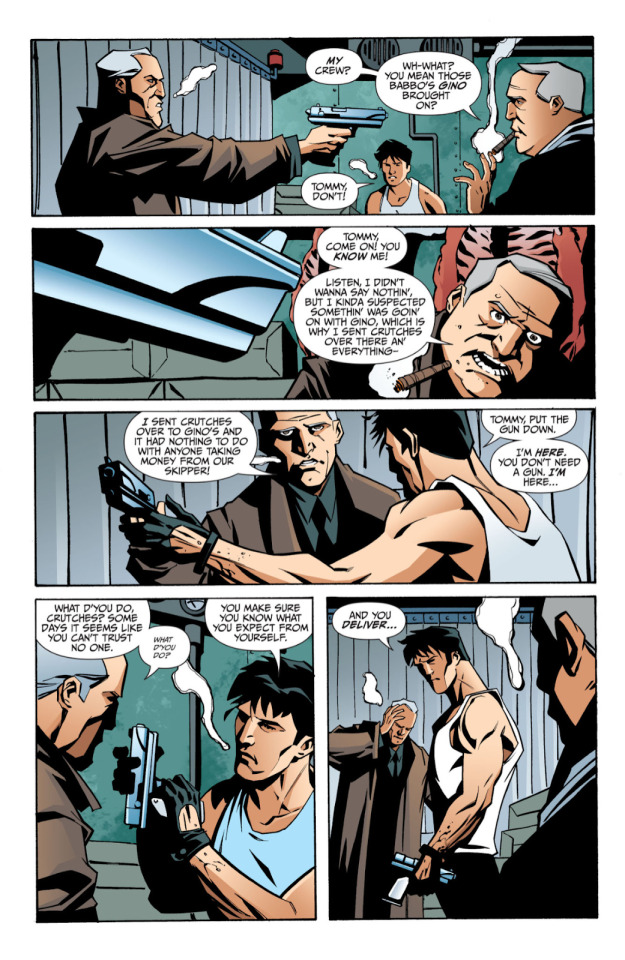
(Grayson, Devin, writer. Hester, Phil Cold Turkey. Nightwing. 109, e-book ed. DC Comics, 2005. pp. 11 - 12)
Dick also interacts with those who ended up caught up in such a dark world through no fault of their own. When Dick, acting as Crutches, beats up a mobster, he discovers his innocent girlfriend and the girlfriend’s child were in the house. While Dick, as our hero, did not allow any harm to come to them, the trauma they went through is not ignored by the narrative.
In fact, not only is it acknowledged, but when Angie Malazavos comes to the police with information on the mob — something that could only happen thanks to Dick and Amy successfully removing a majority of dirty cops from position of power — we see that trauma repeated as the police raids the house of the mobster who began the attack.
Memorably, this leads to Sophia Tevis, the fifteen year old daughter of said mobster, to not only become an orphan, but embody that uncomfortable synthesis of crime and innocence after she witnesses her entire family — a family who loved and doted on her — being killed by the police
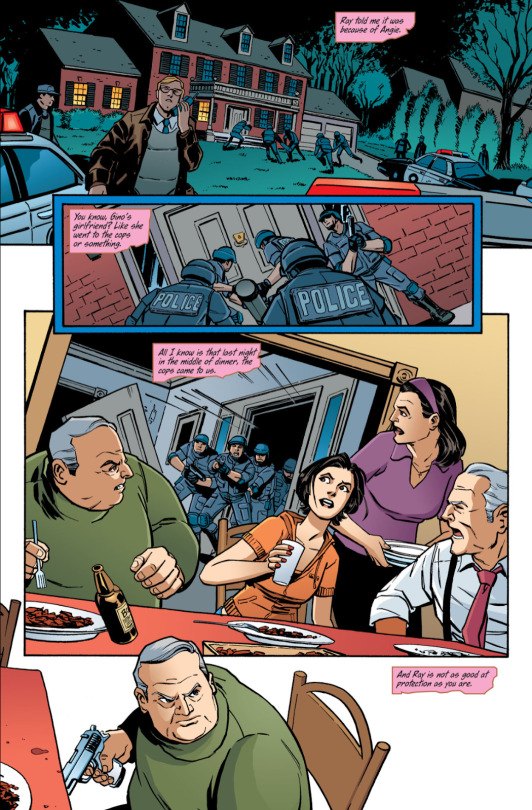
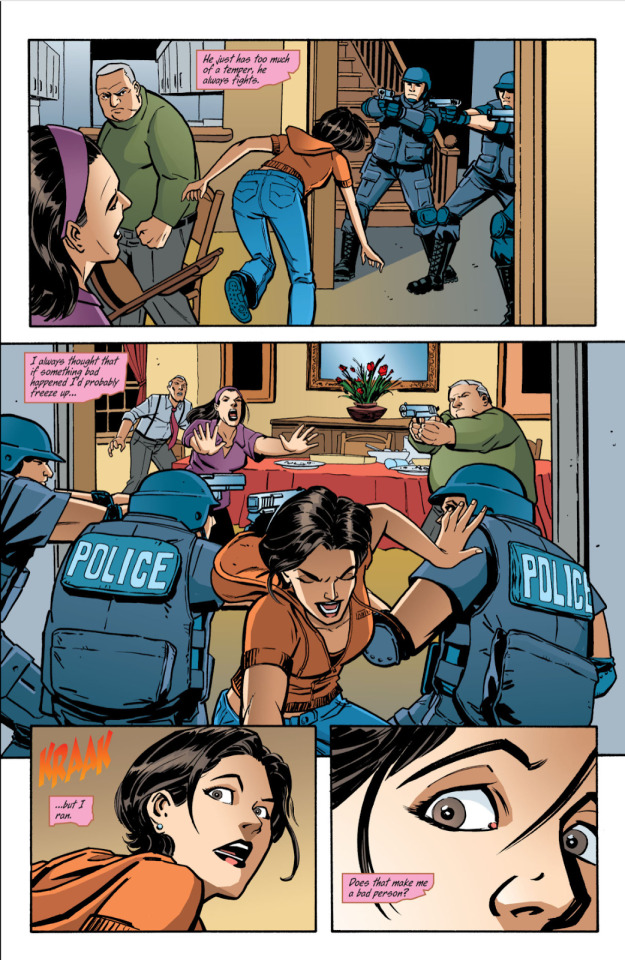
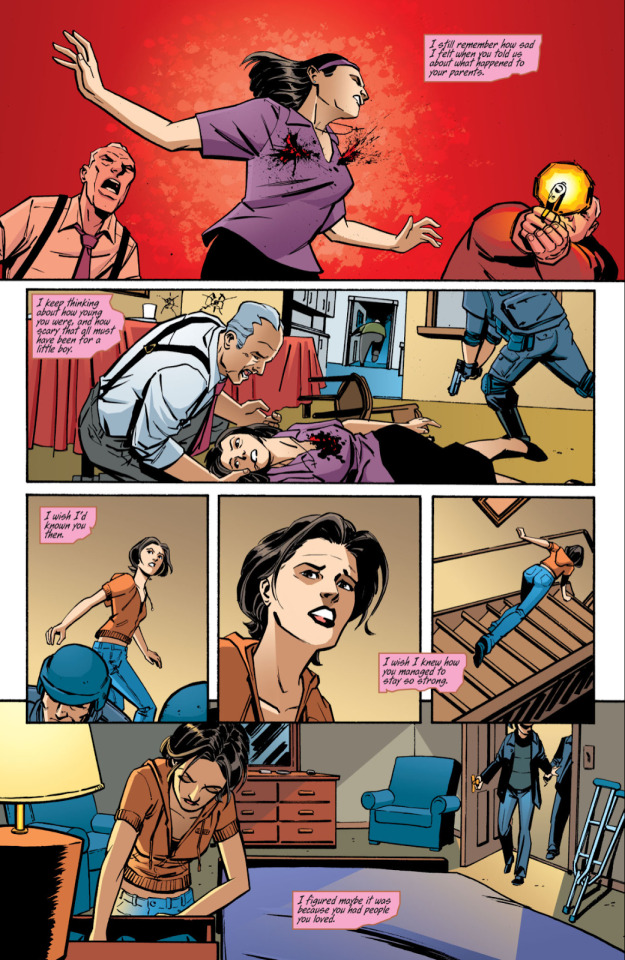
(Grayson, Devin, writer. Chiang, Cliff, illustrator. Signed, Sophia. Nightwing. 111, e-book ed. DC Comics, 2005. pp. 5 - 7)
As he takes her under his wing, Dick and the reader are forced to confront the unclear position people like Sophia occupy in a world that attempts to create clear divides based upon not only actions and motivations, but relations.
By contrast, Taylor’s Bludhaven is too… Nice. Like his characters, it lacks any substance or personality, being a shallow and bland setting without true flaws or appeal. By blaming Blockbuster and his cronies for all that is wrong in Bludhaven, Taylor cheats himself of the opportunity to give Bludhaven flavor. He creates a world where either you are a rich man taking advantage of others or you are a helpless victim who has a good heart and will always be selfless.
This simplistic morality and the surface-level portrayal of Bludhaven as a city not only proves that Taylor gives the city he is writing about no true thought, but it also shows how Taylor’s supposed interest in progressive messages and socially-conscious themes is an incredibly shallow one. After all, if Taylor truly wanted to explore themes of class inequality and systematic injustice, then such a simplistic moral approach works against the innate human messiness and structural complexities inherent in these themes. It is not the themes or its messages, therefore, that interest Taylor, but rather the prestige that comes from being viewed as someone writing about these issues.
This once more shows that Taylor does not care about the story he is telling, the characters in his care, the themes he brings up, and the city whose legacy is in his power to shape. He is not approaching his run from the perspective of a writer, but rather, of a person who chases clout on social media.
As Braxis pointed out in his article, engaging with these themes is difficult. Engaging with it well — truly entering the conversation about real world political, social, and economic problems — is even more so, especially when you also have to tell a satisfying story that does come across as preaching. More than that, though, a story that so directly confronts these issues must, in order to be effective, force the reader to come to terms with their own culpability in a system that is far larger than the individual. It must force us to be uncomfortable and have us ask ourselves how we can bring on change, even in some small way. If such stories are not willing to have the reader be truly emotionally uncomfortable, then they are simply appropriating the pain and suffering of others for a bit of socially progressive coat of paint.
Taylor does not want his readers to be uncomfortable. He does not wish to upset them. He does not wish them to worry or even feel the slightest bit of tension by having Dick be wrong or someone say something mean. He refuses to portray all the many ways evil can manifest in society, all of the petty cruelties everyday people inflict on each other, the apathy of those who are comfortable, the way many must force themselves into individualistic selfishness in order to survive or in order to protect those they love. Taylor doesn’t allow for the pettiness in his world, where, in #87, even a random passerby must happily offer up his bike to Nightwing without questions or expectations.
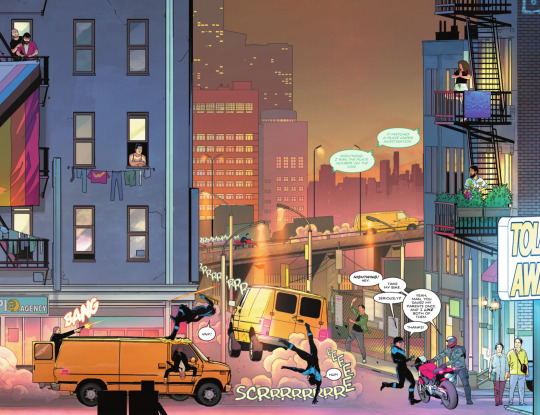
(Taylor, Tom, writer. Redondo, Bruno, illustrator. Get Grayson. Nightwing: Rebirth. 87, e-book ed. DC Comics, 2021. pp 08)
Taylor’s depiction of Bludhaven betrays a very juvenile idea of what good and evil means, a very simplistic idea of how the world works, and very easy solutions to fixing difficult problems, with all of the woes being “fixed” when good guys like Dick, Babs, and Melinda are in power. If you are not one of the main characters, then you are either a corrupt criminal using their money to take advantage of people, or you are a poor helpless victim. There’s no in between, no space for the mundane evils of the world or the average heroics of average people.
As Braxis pointed out when discussing the superficiality of Taylor’s social critique: Son of Kal-El and Nightwing demonstrate a pattern in Tom Taylor’s writing where social issues are used as plot devices, but there is a performative contradiction this ends up creating. Jon and Dick are exposed to social issues as a gateway to criticize their mentors. However, their lack of understanding about the issues they’re exposed to means their own criticisms can be thrown back at them.
(Braxi, Steve, “On Superman, Shootings, and the Reality of Superheroes” Comics Bookcase, September 2021)
Please note that I'm not saying that exploring class inequality and systematic injustice aren’t interesting lenses through which one can explore Bludhaven. However, by making Bludhaven such a friendly yet passive city, Taylor stumbles onto a trap of his own making. He uses no metaphors, no allegories, no symbolism, no fantasy or science fiction elements to create distance between the narrative and the real world, allowing more freedom with how these topics could be discussed. Taylor decided to tackle, as Braxis characterized, “shallow criticism, a criticism in bad faith” by directly engaging with these real world problems, and as such, he took on work that was not only far beyond his capabilities as a mediocre writer, but work that he clearly has no interest in undertaking.
To have to read about this Bludhaven after we had Humphries and Chang’s depiction feels even more like a knife to the heart of every Dick Grayson fan.
Humphries’ The Untouchable, Bludhaven’s corruption and evil is beyond “generic” police corruption. It is specific. It is unique. Bludhaven has a history. It has personality. Humphries’ run touches on themes of corruption both through the fantastical use of the Judge, and by the very specific scenario of Bludhaven’s unique economic problems. This Bludhaven’s economy is so deeply tied to a rotten, corrupt system that everyone ends up being both victim and perpetrator. The system harms all of them, but without it, they cannot survive.
The casinos were corrupt, stealing money from schools, lining its owners pockets, controlling the mayor through bribery and blackmail. But Bludhaven is also dependent on the casinos. Its economy is entirely dependent on them to the point that even those who do not work directly with the casino still need them to thrive. This creates a fascinating and complicated scenario where weeding out the corruption that led to so much suffering will not solve anyone’s problem. In fact, as the story demonstrates, it can even make it worse.
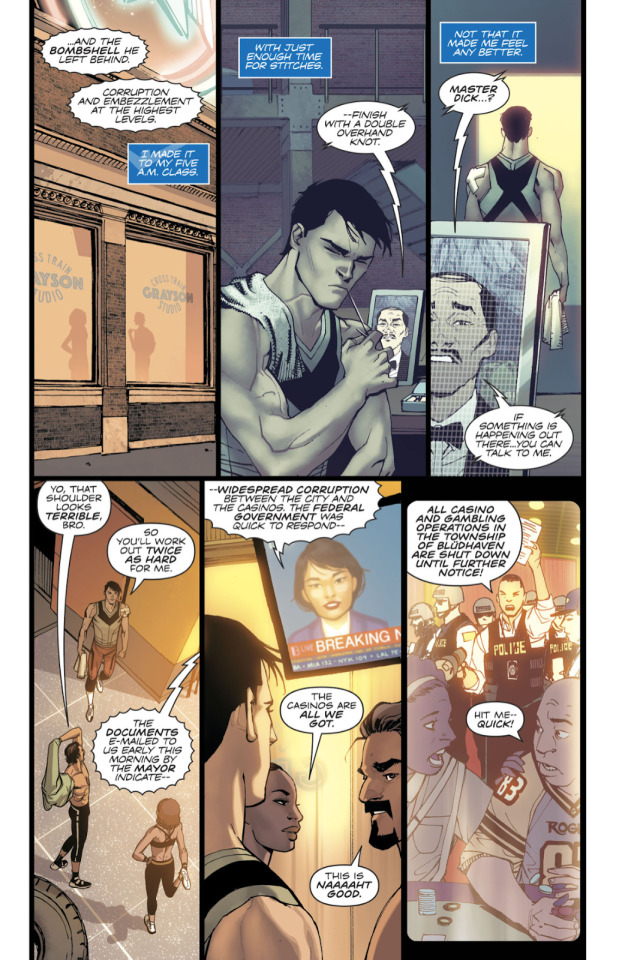
(Humphries, Sam, writer. Chang, Bernard, illustrator. The Untouchable: Chapter Two: Relentless. Nightwing: Rebirth no. 36, e-book ed. DC Comics, 2018. pp. 21)
For a more concrete example of how Humphries and Chang were able to flesh out Bludhaven in five issues so much more than Taylor and Redondo did throughout all these years, I want to compare Humphries’ handling of the Justice Tree with Taylor’s handling of the Octopus statue in the beginning of his run.
Humphries’ Justice Tree not only creates a concrete and identifiable landmark within the city, not only is it connected to Bludhaven’s history, The Untouchable’s main antagonist, and Dick’s personal relationship with the city, but it is also tied to the themes of the plot.
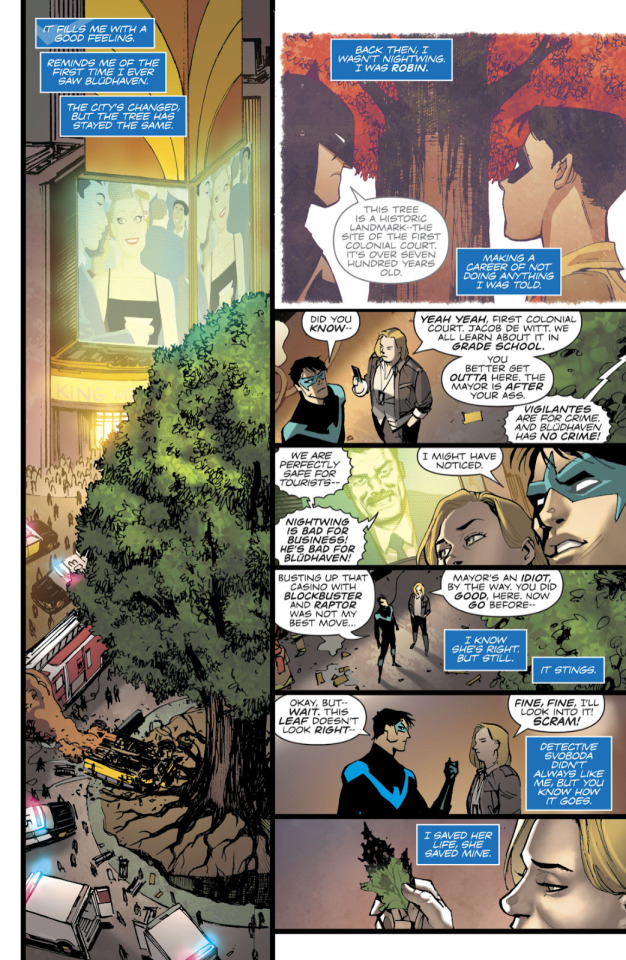
(Humphries, Sam, writer. Chang, Bernard, illustrator The Untouchable: Chapter One: Hunter. Nightwing: Rebirth no. 35, e-book ed. DC Comics, 2018. pp. 12)
In The Untouchable, the Justice Tree is rich with symbolism. First planted in Bludhaven by The Judge while he was still human, symbolizes, well, justice. As the Judge’s return and his machinations reveal the rot that had been seeping into Bludhaven, the tree begins to wither, its centuries old existence threatened. As the tree’s fate is at risk, so is Bludhaven’s.
The narrative goes back to the Just Tree just at the right beats, emphasizing the thematic core of its story. It also contributes to the plot by becoming a ticking clock. It’s threat countdowns to the big climax of the story, when Nightwing and the Judge will battle for Bludhaven’s soul. It is notable that while the Justice Tree was first planted by the Judge, it is Dick’s efforts that manage to save it, so even though both men are fighting for what they believe to be right, everything about narrative indicates that Dick is the one who ultimately has what it takes to save Bludhaven from corruption.
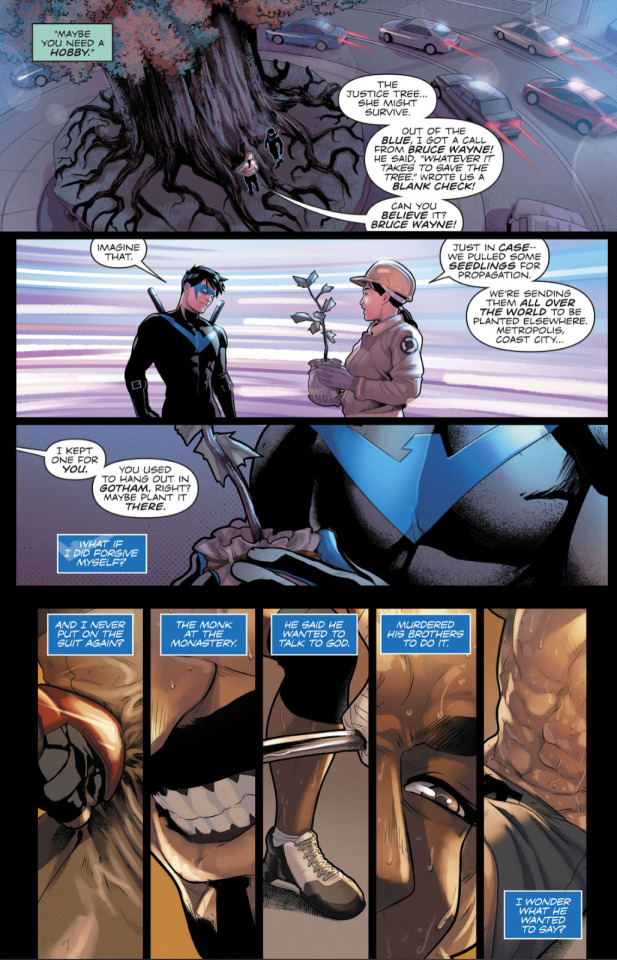
(Humphries, Sam, writer. Chang, Bernard; Campbell, Jamal, illustrator. The Untouchable: Chapter Seven: Final Judgment. Nightwing: Rebirth no. 41, e-book ed. DC Comics, 2018 pp. 22)
That being said, another big theme of this story is forgiveness and kindness, two principles that are essential to Nightwing. Dick emphasizes that no one should be judged by their actions when they are at their worst, so long as they decide to move forward and do good.
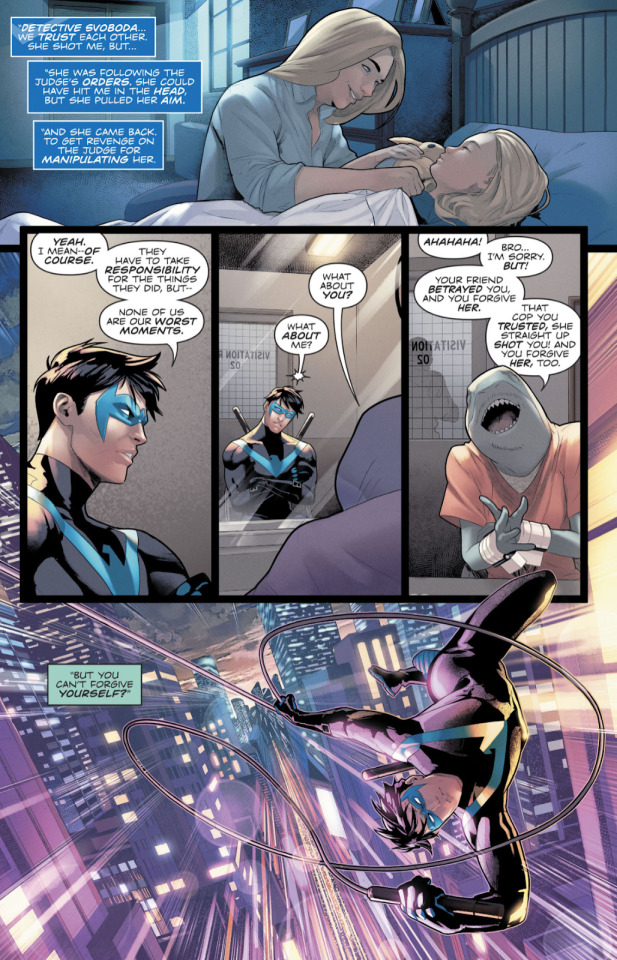
(Humphries, Sam, writer. Chang, Bernard; Campbell, Jamal, illustrator. The Untouchable: Chapter Seven: Final Judgment. Nightwing: Rebirth no. 41, e-book ed. DC Comics, 2018. pp. 21)
And yet, Dick is unable to extend this same kindness to himself. While he is able to forgive everyone around him for giving into the Judge’s temptations, he is unable to forgive himself for being unable to stop the Judge sooner.
These themes are embodied in the Justice Tree, which is threatened when the Judge is at large, and then is given a chance of salvation when he is captured by Dick and he is able to convince Bruce to invest in the efforts to keep the tree alive. The story concludes with Dick being given a piece of it to plant wherever he chooses (and he chooses close to his home, to Nightwing’s headquarter, the perfect marriage between Dick Grayson and Nightwing).
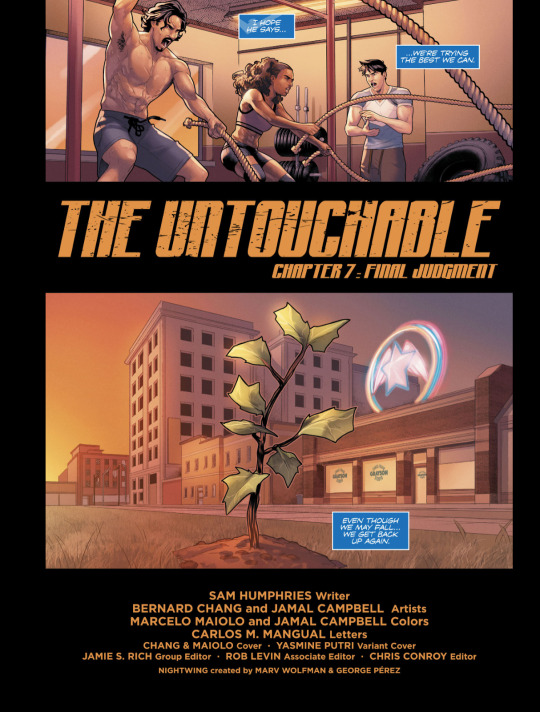
(Humphries, Sam, writer. Chang, Bernard; Campbell, Jamal, illustrator. The Untouchable: Chapter Seven: Final Judgment. Nightwing: Rebirth no. 41, e-book ed. DC Comics, 2018. pp. 23)
And that is not even to mention the way the art manages to convey so much. The tree that symbolizes justice is surrounded by the corrupt casinos. Nature is surrounded by artificial neon lights, circling in it, caging it so that it cannot branch out, cannot expand, cannot grow. The more natural, soothing colors of the tree contrasted against the bright neon colors of Bludhaven. The sharp lines of the tree vs the blurriness of the city. All of it visually conveys the main conflicts of the story that work together with its themes.
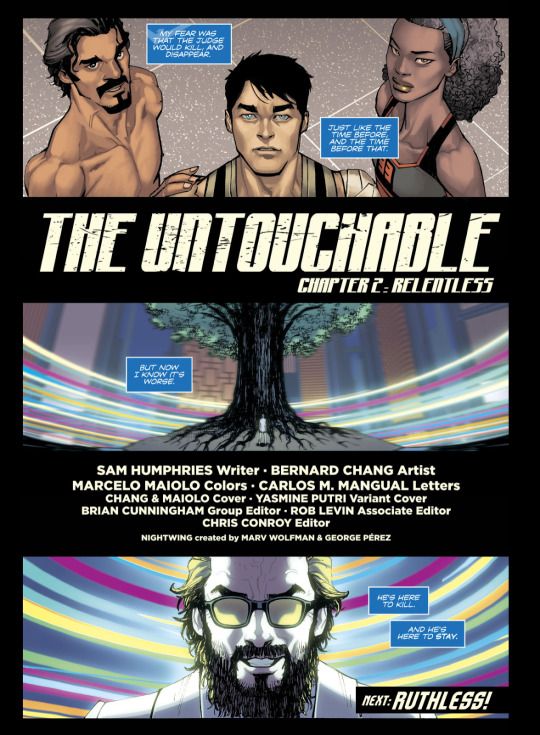
(Humphries, Sam, writer. Chang, Bernard, illustrator. The Untouchable: Chapter Two: Relentless. Nightwing: Rebirth no. 36, e-book ed. DC Comics, 2018. pp. 22)
By contrast, Taylor’s depiction of the Octopus Statue feels… Lacking. When looking at it with Babs, Dick ruminates on the history of Bludhaven and how it symbolizes Bludhaven’s resilience. He connects it to the city’s history and to how the people of Bludhaven can overcome even the most difficult challenges. In doing so, Dick also asserts his mission statement — he wants to be the safety net for these resilient people, he wants to be their protector, he wants to prop them up, to give them someone to rely on so they won’t feel abandoned.
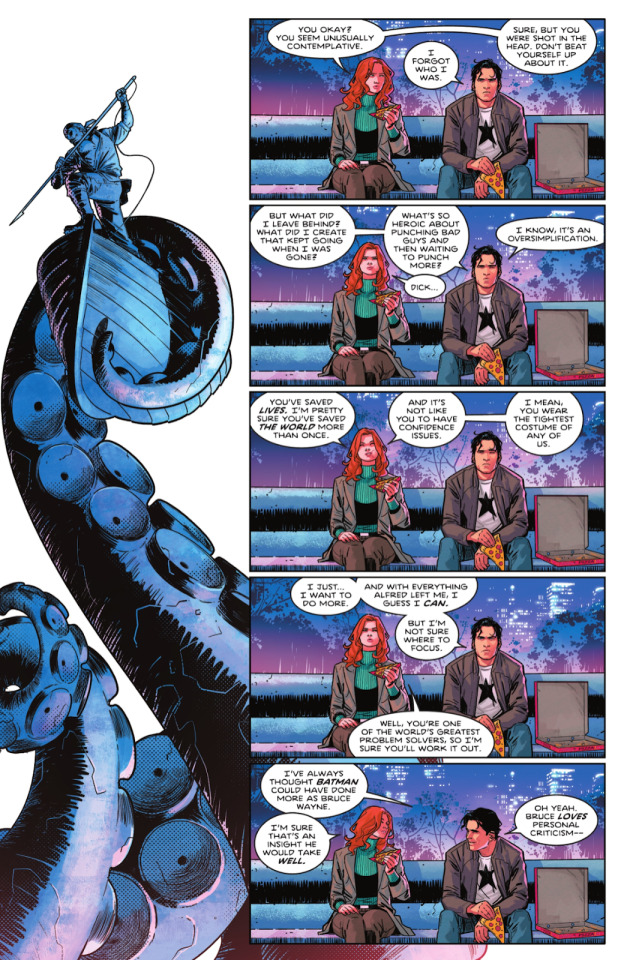
(Taylor, Tom, writer. Redondo, Taylor, illustrator. Leaping into the Light Part Two. Nightwing: Rebirth. 79, e-book ed. DC Comics, 2021. pp 07)
And yet, how many times do we come back to this one location that, in the beginning of Taylor’s run, was tied so strongly to Dick’s mission? How many times does Dick come to look at the statue? Dick is not given any crisis of faith because of the lack of conflict in the story, and yet, scenes in which he ponders whether he is going about his mission the right way while looking at this statue would have effectively shown the themes of the story and Dick’s inner struggles all while fleshing out Bludhaven.
Instead, Taylor readily abandons the statue just as soon as it is introduced. We don’t return to it, we don’t even use it as a set piece that can ground Bludhaven and make it feel like an actual place. It doesn’t make an appearance in any covers, nor in establishing shots. In fact, even its thematic symbolism is forgotten when Alfred’s statue is built. Such a decision is especially infuriating when one considers the fact that not only would Alfred hate having a statue in his honor, but that Alfred means absolutely nothing to the people of Bludhaven. He means something to the reader, but not the citizens of the city that Dick is meant to protect. In this, we see how once more Taylor’s online mindset interferes with his storytelling, replacing a set piece that was tied to the in-universe history of the city he was writing with fanservice.
(CONTINUE IN PART 2)
46 notes
·
View notes
Text
Ok ok my guess is that things have already died way down for The Bear fandom but I've made several posts defending season 3 now which I only did because I was so stunned to see that the fandom's criticisms of this season were mostly of legitimate and frankly common sense writing decisions and now that I've gone over all that - I thought I would share the few criticisms I do have for this season, starting with the one I think is the most damning:
The theme of gentrification being treated like a footnote.
In season 1 there was a very purposeful commentary on the implications of Carmy taking over The Bear, and immediately changing the culture of the kitchen to reflect his own, very high-end, culinary background. At one point there's a drive-by shooting and their front window gets shot out. Sugar asks about calling the cops and everyone but her immediately shuts it down. Sugar is a white woman currently living in what appears to be a more middle-class suburban area of Chicago, and so naturally she doesn't see any problem with calling the police. Everyone else understands why the police, under no circumstances, should be called.
Richie dwells on "the delicate ecosystem" of this specific corner of Chicago changing. He comments on how changing any tiny thing has devastating consequences. He brings up the statue without a face that was placed on top of what used to be the tallest building in Chicago and how so many buildings have become that tall since that everyone can tell she doesn't have a face. This is a very astute metaphor for the soullessness of a gentrified Chicago. Richie also mourns the loss of a pub down the street, not because he frequented it but because it was a staple. It had always been there, and now it was forced to close.
In this same episode, the people who hang out on that street have begun crowding closer to The Beef, and when Richie approaches one of them, he asks Richie, "Are you going to call the cops?" and Richie is offended, and says, "I would never." The person explains they can't hang out where they normally do because of construction - a newer, flashier institution is being built on that street and displacing the very people who occupy it. These same people who hang out on that street get in a dispute, and once again, calling the cops is not an option. Richie panics, trying to find his gun to scare them off, and Sydney resolves the issue by promising to feed them every Tuesday as long as they keep the peace. At the end of the episode, Richie steps out to smoke a cigarette, and down the street police cars roll up with their sirens flashing, and Richie shakes his head.
This episode beautifully showcases the value of community organization, as well as the harms of gentrification.
It would stand to reason that in following seasons The Bear would have continued exploring the implications of these characters opening a high-end - potentially Michelin-star no less - restaurant in the same building that was once The Beef, where regulars frequented and where employees weren't expected to provide impeccable, inhuman service. The people who worked at The Beef were allowed to yell, to swear, to be conversational with customers, and the regulars were regular entirely because they could afford the food. The atmosphere of The Beef, however unprofessional, however classless, was human, and once again a place for community.
But in the following season, the decision to keep the restaurant window open during the day so that the regulars can still buy food from the old menu is treated like a band-aid solution to the entire theme of gentrification, and there's little more said about it. The very characters who were once allowed to be imperfect and human and on equal footing with their customers now must dedicate themselves to impeccable, inhuman levels of "service."
And while I will say that "Forks" is possibly one of my favorite episodes in the whole show, maybe even my favorite, and that I get deeply emotional every time I watch it because it is just so beautiful, the way it takes a job - being a server - that most people have little regard for, and most people dread doing, and present it as something rewarding, and fulfilling, and deeply meaningful - I'm nevertheless critical of romanticizing that level of service, especially given that that level of service is functionally required because of how expensive the restaurant is, making the beauty of finding purpose in service about serving the ruling class, rather than just serving others, or serving your community.
The episode "Forks" draws attention to the idea that the reason these servers can do this is because "everyday you make someone's day" and on top of that, they show people being informed that their meal that night was "on the house." This is not the reality for most people dining in these restaurants. In real life, most people dining in these restaurants are not having a once-in-a-lifetime experience that they've saved for and dreamed about - it's Tuesday to them, because they're so filthy rich, they can do this kind of thing whenever they want. And of course, most guests aren't going to be told their meal is on the house - this can't ever be the case, because the entire purpose of everything about the restaurant that makes it such an experience is money.
I understand why this side of things wasn't explored in the episode "Forks," which needed, for the sake of Richie's character arc, to be as romanticized and inspiring as it was, and I wouldn't change it for the world. But there was more than enough room to make a more purposeful commentary about this side of "service" and this side of "high-end" restaurants in season 3 - and there's nothing. There was even more room in season 2 elsewhere - and again. Nothing. Even when Sydney is researching for The Bear menu and becoming overwhelmed with how many restaurants are closing - this is not touched on in order to continue a commentary on gentrification or capitalism. The only purpose of it is to demonstrate the stakes for The Bear.
And then on top of this, they are opening this restaurant in the wake of the height of the pandemic, which a lot of restaurants didn't survive, and there's no one talking about the fact that the last thing most people need post-pandemic is a high-end restaurant they can't afford to go to. There's no commentary on how part of the reason restaurants are dying as much as they are is because people literally just can't afford to eat out anymore.
Now...any time I'm critical of some component of a written work, I have to make the distinction: "Do I dislike this because it's bad writing, or do I simply dislike it?"
in this case, I think I would have leaned toward, "I just dislike it," except for the fact that they bothered to introduce the theme. If Storer had, from the beginning, purposefully decided that his story wasn't about gentrification, and wasn't going to explore it - I still would have disliked it. I still would have thought it was an oversight, and a missed opportunity -
But it was introduced. It was very purposefully explored in season 1, and it was explored beautifully. And then they slapped a narrative band-aid on it and moved on, as if serving sandwiches through a drive-by window during the day completely tied up that narrative thread. To me, it screams, "If I want to write about people opening a high-end restaurant in Chicago, people are going to expect me to acknowledge the implications of that, so here. I talked about it. Can I write my story now?" It's just so...tacked on. It's the narrative equivalent of a diversity-hire. Like Storer was just checking an obligation off a list. And now, the writing is worse for it, I think.
There are times when the story comes close to touching on it again, and other times when there was so much opportunity to. We see Tina struggling to find a new job after being let go from her place of employment of fifteen years. Storer took the time to show us this and then really didn't say anything with it. We understand how important this restaurant is to Tina now, how much she can't afford for it to fail - but this still doesn't really say anything about the standard of living in Chicago. The fact that it's set so far in the past begs for a modern comparison, begs for something to be said about how much worse it's gotten since, and why - and yet, nothing.
Marcus's mother needed full-time medical care. Marcus was also already employed at The Beef before Carmy arrived, and it doesn't appear that he or anyone else in his family has any other source of income. He has a roommate, which would ease living expenses, but wouldn't do anything to help with medical debt, and the fact that he has a roommate also demonstrates that he couldn't afford to live on his own. There's no way he was getting paid that well at The Beef - and did employment at The Beef come with any benefits? Health insurance? Not a chance. Yet in season three, the reason this restaurant is so important to Marcus is because his mom wanted it for him. That's a lovely sentiment - but I'm also left baffled by the decision to at no point bring up the cost of his mom's healthcare, and the debt Marcus is likely swimming in.
There were opportunities to use both Tina's and Marcus's backgrounds to contribute more to the gentrification commentary. It would have provided a juxtaposition - yes, it's unfortunate the neighborhood is being gentrified, but look at how it's potentially benefitting and providing hope to these impoverished people. But once again, Storer doesn't make any obvious effort to continue exploring this theme. He is treating it as though it's been wrapped up, as though he's said everything he needs to say, as though he ticked off the "gentrification elephant in the room" box and is now free to ignore the same setting and circumstances he purposefully chose to set his story in.
It is, in my opinion, wasted narrative potential and a huge oversight on Storer's part. Frankly, I think it's possible this story, when finished, will miss its own point, or at least part of its own point, if Storer continues to treat this theme like it's been taken care of already. I'm holding out hope that he's building toward this conversation again, that he at some point does something with Tina's and Marcus's background, that he maybe even explores Sydney's feelings about it, and possibly uses it to develop her character in an interesting way...but I'm not holding my breath.
#the bear#the bear fx#sorry I was initially going to include all my criticism on this same post#but this is already so long that I'm going to leave it and just make a different additional post#long post
21 notes
·
View notes
Text
Title: Trial By Fire
Rating: T+
Warnings: Referenced Alcohol Abuse/Alcoholism, Underage Drinking, Drug Use, Referenced Suicide, Weed Use, Dark Themes
Relationships: Background Dartz x OC. Referenced Past Malik x Yami Bakura. (Malik x Siegfried if you squint.) (Malik also kisses some random pretty boys but its nothing serious.)
Chapters: 5/20+
Other Tags: Post-Ceremonial Duel, Not DSOD Compliant, Multi-Chapter, Uses Japanese Names, Queer Themes
Summary:
Everything seems peaceful since Atem left, but when trouble stirs in Hawaii, it's up to Yugi, his friends, and even some former enemies, to save the world from the war raging between two sister goddesses: Pele-honua-mea, and Nāmaka-o-Kahaʻi.
A hyper-indulgent Yugioh fanfiction in support of Hawaiian Sovereignty, over 15 years in the making. Loosely based off a RP.
Featuring:
Redeemed villains coping with guilt!
Yugi dealing with post-Atem grief!
Malik in a rock band!
Dartz getting some poetic justice!
Amelda being a (traumatized) badass!
Siegfried going hashtag through it!
Communism, Harm Reduction, and Mutual Aid Hubs, oh my!
Punk house shows!
A fat OC who’s seen as sexy and is a valid romantic interest!
A Hawaiian mahu trans woman OC!
10+ additional named OCs of color!
Narrative condemnation of white supremacy, colonization, and gentrification!
6 notes
·
View notes
Text
The Philosophy of Metropolitanism
The philosophy of metropolitanism centers around the unique social, cultural, and economic dynamics of metropolitan (urban) areas and examines how these environments shape human experience, social structures, and values. Metropolitanism views cities as hubs of diversity, innovation, and complex social interactions, which stand in contrast to more traditional or rural ways of life.
Key Themes in Metropolitanism
Urban Identity and Cosmopolitanism: Metropolitanism often emphasizes cosmopolitan values, where individuals are exposed to a range of cultures, ideas, and lifestyles. Cities foster a sense of open-mindedness and adaptability, as people encounter diversity and interact with individuals from various backgrounds.
Collective and Individual Identity: In metropolitan environments, there is often a tension between collective urban identity (e.g., being a New Yorker, Londoner) and the individual’s quest for uniqueness. City life often supports personal expression while also creating a shared cultural experience within neighborhoods, workplaces, or social circles.
Innovation and Progress: Cities are frequently seen as engines of progress and change. The metropolitan lifestyle values innovation and entrepreneurship, spurred by dense social and economic networks that encourage rapid exchange of ideas, resources, and opportunities.
Alienation and Anonymity: Metropolitanism also considers the challenges of urban life, such as alienation, stress, and a sense of disconnection, despite being surrounded by people. Some argue that cities can lead to impersonal relationships, as individuals are constantly moving and adapting to the fast pace of urban life.
Social Complexity and Hierarchies: Cities create complex social structures, with different socioeconomic classes, professional networks, and communities. Metropolitanism examines how these layers contribute to both opportunity and inequality, and how urban policies impact issues like gentrification, housing, and public services.
Public Space and Community: The philosophy of metropolitanism also considers the importance of public spaces—parks, squares, and cultural sites—in fostering social cohesion and community life. These spaces serve as places for connection, recreation, and political expression, balancing the private and public spheres in dense urban landscapes.
Environmental and Sustainability Concerns: Urban environments are increasingly under scrutiny for their impact on the natural environment, and metropolitanism encompasses discussions on sustainable city planning, green spaces, and the need for eco-friendly solutions to address issues like pollution, traffic, and energy use.
Philosophical Perspectives on Metropolitanism
Urbanism and the Human Condition: Thinkers like Georg Simmel and Walter Benjamin have explored how city life affects the individual’s psyche, noting that the sensory overload and rapid pace of cities influence people’s ways of thinking and relating to one another.
Metropolitanism and Social Theory: Urban theorists, such as Henri Lefebvre, emphasize the “right to the city,” which argues that city residents should have a say in urban planning and access to its resources, promoting an ethical perspective on urban living.
Globalization and Cultural Exchange: Cities are often at the forefront of globalization, and metropolitanism reflects this interconnectedness, where metropolitan areas serve as cultural and economic nodes in a global network. This raises questions about cultural preservation, assimilation, and the impacts of international influence on local customs.
Critiques of Urban Capitalism: Many theorists critique the capitalist structures prevalent in urban centers, arguing that metropolitan areas often become sites of economic disparity, where wealth and poverty are starkly juxtaposed. Scholars like David Harvey analyze how urbanization serves capitalistic interests, often prioritizing profit over the welfare of city dwellers.
Postmodern Urbanism: Postmodernist thinkers suggest that metropolitan life challenges traditional norms and hierarchies, giving rise to new forms of community, identity, and cultural expression. The postmodern city is seen as a space of fragmentation but also of new opportunities for redefining social relations.
Influence and Application of Metropolitanism
Metropolitanism has practical implications in urban planning, sociology, and environmental policy. It influences how cities are designed, addressing issues of accessibility, inclusivity, and sustainability. Additionally, metropolitanism shapes cultural policy and education, as cities are hubs for art, music, and intellectual exchange. It also informs political theory, with cities often being centers for social movements and advocacy for issues like civil rights, environmentalism, and economic equality.
#philosophy#epistemology#knowledge#learning#education#chatgpt#Metropolitanism#Urban Philosophy#Cosmopolitanism#Urban Identity#City Life and Community#Social Theory and Urban Studies
2 notes
·
View notes
Text
Moon Girl and Devil Dinosaur is AWESOME!!!!!!
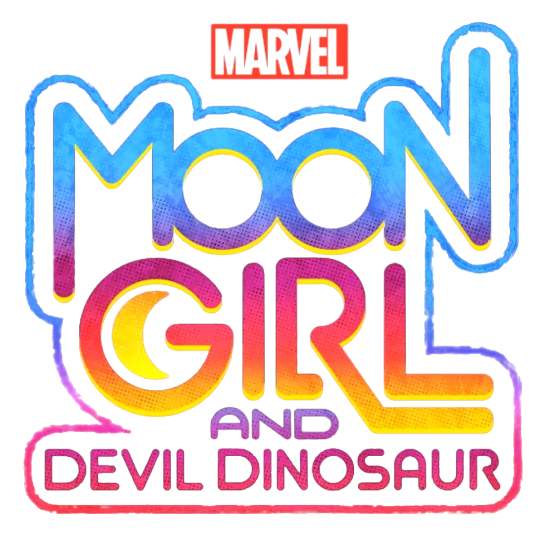
OK so, have you ever went to watch a show, that you expected to just be a fun 7/10 series only for it to absolutely blow you away with how well-written fun, and GREAT it is? Well, Moon Girl and Devil Dinosaur was that show for me. This show only has 1 season released so far and it has already become my new favorite cartoon of ALL time. But why is that? Well, let's dive into why Moon Girl and Devil Dinosaur is an awesome series.
NOTE: I have not read the comics this show is based on, so this is judging it as a stand-alone show and not an adaptation. Oh, and this review contains spoilers for the series, you've been warned
1. The Art Style & Animation
I LOVE this show's art style. It looks like it comes straight out of a comic book with the character designs, the backgrounds, the thick outlines on the characters, the bright colors that pop in every scene, this show looks GREAT! The animation also gets cool and creative in the show's action-music video like sequences at the end of each episode where they change the colors of each character AND they use some cool ass and creative animation in each of these sequences too, whenever these pop up in an episode, they are always great to look at. And then there are the fights in this show outside of that and they look great too! Overall, this show has a fantastic art style that looks pleasing and fun to look at.
2. The Music
DAMN does this show have an amazing soundtrack. I LOVE every single song here. They are just super catchy and great to listen to, and remember those sequences at the end of each episode I mentioned in the previous section? Well, these sequences have some of the BEST songs in the whole show. My favorites are definitely the ones in the last two episodes, both of which are 70s remixes of the theme song, which is also a BANGER too! Other great songs include My Hair is a Mood, The Wave, The Beyonder's Song, Out of My Mind, Go Big, The Look in Your Eyes, and MANY other ones as well! This show has the best soundtrack out of ANY cartoon I've seen. Go listen to this show's soundtrack right now, it's actually amazing.
3. The Characters
Okay, enough of praising the superficial aspects about this show, now, it's time to praise the other parts of it; that being, the characters.
Lunella- The main protagonist of this show, and she's great. The show does the usual things that all good shows do and that is teaching its protagonist lessons, however, Moon Girl and Devil Dinosaur does this so incredibly well that it makes Lunella a great protagonist. You have Lunella learning pretty basic lessons like being patient and not feeding internet trolls when they say mean things about you online, they also have her grow as a character like learning to face her childhood fears in episode 14, and learning that, fear isn't something you should get over, it should be something you should get through.
There's also episode 7 where she learns to overcome her awkwardness whenever she's in a slumber party and becomes better at making friends. Even basic lessons she learns like in episode 4 where she learns that she shouldn't be overly competitive add so much nuance to that moral. LOS-307 (the robot Lunella competes against in that episode) wants to try and connect with Lunella because they don't really have any friends, yet Lunella ends up ignoring that and gets so focused on the game that LOS ends up being turned on while they are on charging for so long and overheats, because Lunella was too caught up in the game. She was too obsessed with winning and that cost her almost getting killed. Other episodes like the one where she learns that it's ok to say when you need a break from stuff, the one where she learns that what makes life special are all the fun moments in between are also all great too.
But the episode where her character is at her absolute best imo is in episode 11, AKA; the gentrification episode. In that episode, she learns that she, as Moong Girl, is a voice for the community of the LES, and a role model, and she meets these two guys Marty and Marcy, who want to revitalize the LES to be "better". She thinks that it would help the LES only to see that the changes Marty and Marcy make are affecting the LES for the worse, gentrifying it. She then gets scolded by her mom as Moon Girl saying "how could you support something like this?". She used her voice in a way that badly affected her community, and then there's that AMAZING scene with her mom as herself, and says that she tried to use her voice, but it turned out it didn't matter.
And then she learns that she needs to use her voice wisely as Moon Girl, and that her voice does matter, she just needs to make herself heard. And then goes to fix this and bring back her block from it's gentrified state. I'll talk about this episode more in the next section, but it did such an amazing job of making Lunella a FANTASTIC protagonist. She's flawed, she makes mistakes and those mistakes have big consequences, but she learns and grows from those mistakes. Oh ya, I could also mention many other episodes like episode 5 but I think you could get the idea; Lunella is a great protagonist. Grows throughout the whole series and each episode finds a new way to make her develop in a way that's compelling.
Casey- I have a lot less to say about Casey than I do about Lunella, but I still really like Casey. She's the social media-obsessed popular girl in this show and normally with these two types of characters Casey would be a bully to Lunella, but that's subverted here which is nice. I also love Casey and Lunella's friendship, it's really cute and they a lot of great chemistry with each other that makes their dynamic interesting and fun!
Episode 12 is the episode where Casey goes through a bit of character growth, as she throws bat mitzvah and has Moon Girl make an appearance so it could be the most epic one, only for Casey to become too obsessed with the bat mitzvah to the point it creates a rift in her friendship with Lunella. I think that episode did a good job of making Casey go through some character growth, and overall, she's a fun character and a great tritagonist.
Devil- Devil's cute. I like him. Devil is Lunella's suto pet/crime fighting partner, and I do like him. Like with Lunella and Casey, there are episodes that give him a little depth, like episode 8 or episode 13, these episodes focus on Devil and they are pretty good, not the best episodes of the series but they are still great. Devil's friendship with Lunella is cute too, they have such great chemistry with each other. Devil is a good deuteragonist for this series.
So Moon Girl and Devil Dinosaur has a pretty great main cast. The characters are likable, and get great growth throughout the series. Now let's talk about...
4. The Villains
Moon Girl and Devil Dinosaur is a superhero show, so it's going to have a lot of villains. Most of the time these guys usually appear for only one episode to serve the plot for each episode. The first villain, Aftershock, is the main antagonist of the pilot, and she does a decent job as the show's first major boss. She's funny, she's threatening, and her design looks pretty cool. Next is the Syphonater, AKA Angelo. Angelo wanted to help the community but never got noticed, and when Moon Girl got all the attention he never received, he became jealous of her which made him susceptible to being a host for the Syphonater. Again, he serves his job fine as being that episode's main antagonist.
Other villains include Gravitas, a villain with gravitation powers who went after Moon Girl and Devil because they accidentally destroyed his car, Mane who is all of Lunella's natural comprised into one giant hair monster thing, Abbyss who can shoot dark cloud things and who doesn't want to be evil, but since she's apart of a family of supervillains she has no choice, LOS-307 who's a supercomputer that turns evil after overheating (I actually got worried for them when it looks like they were about to die like, damn, this show got me to care about a robot...how) and many, many other villains. All of them serve their purpose for the episodes that they are in and they are entertaining to watch. However, there are two villains that I think are the most worth talking about. Those being The Beyonder and another antagonist I'll talk about later in section 6.
The Beyonder is my favorite villain in this show so far. He reminds me a lot like HIM from the OG powerpuff girls; an all-powerful being that likes to torment our heroes for the fun of it. He's just such a fun villain, he basically was sent to Earth so he could study about humans, and when Lunella says one thing about Eduardo being a useless partner, he takes that like her saying that humans are worthless and says that if Lunella doesn't complete her school project with Eduardo, he'll wipe out the human race. Nah, turns out he was just messing with Lunella there. The Beyonder is just such an fun entertaining villain, he's no doubt my favorite villain of the show.
The villains in this series are relatively decent, most of them serve their purpose for each episode that they are in, some are sympathetic and get redeemed at the end of each episode, most of them don't, so this show's villains are pretty solid, now let's talk about...
5. The Morals & Messages
Moon Girl and Devil Dinosaur has the basic kinds of lessons you would see in most kids shows; however, it's the executions that matter here and they way Moon Girl and Devil Dinosaur teaches it's lessons is great! Let me give you an example; Episode 3, this episode has Lunella learning to be patient and that she shouldn't rush things. Basic moral on paper. Then later in episode a villain named Gravitas shows up and begins recking things. How is he defeated? Lunella goes and waits for him to run out of juice so he can't use his gravity powers.
What I like here is that the episode gets its moral across in a creative and interesting way; Lunella defeats Gravitas by waiting or being patient for him to run out of juice so he can't attack her anymore. It gets a moral across in a way that's both creative and entertaining to the audience without it feeling hamfisted. Another example; Episode 4, I already mentioned this episode in the characters section but this is one of my favorite episodes of the show so far. Like episode 3, it takes a pretty basic moral; don't be overly competitive, and does something interesting with it.
In the episode, a new AI comes to Lunella's school named LOS-307, a robot who was just built eight months ago, and Lunella goes to play chess against it. The robot tries to connect with Lunella and become friends, but Lunella is too focused on winning against them to connect. It gets so bad to the point where neither of them beat each other and Lunella is still playing against them even after school is over. And then later in the episode, when Lunella sneaks back into the school to beat LOS once and for all, they end up overheating which causes them to go evil, LOS tells Lunella this before this happens but Lunella is still so focused on winning that she doesn't listen.
Lunella was so focused on winning that she didn't get to connect with someone and she ended up almost getting killed because she didn't listen to LOS's warnings. It takes a moral that has been done to death and does something interesting with it. Another example is episode 9 where Lunella creates a app so she can skip all of the boring parts of her life like doing chores, waiting in lines, and other stuff, only learn that life isn't meant to be a highlight reel, rather its about the small moments in between that give life meaning. Episode 14 is another example, where Lunella has to overcome some childhood trauma where she got lost in a theme park without her grandma Mimi, and encounters a scary clown.
Normally the message here is that you should get over your fear, but the show takes a different direction with this and says that fear isn't something you should get over, it's something that you should get through and that it's OK to be scared, as it's something that we always have to deal with.
This show is great at teaching morals in a way that's both entertaining and doing different and more interesting things with those morals. They never feel hamfisted or anything, and the show adds it's own spin on morals that have been done to death by doing them in interesting ways. But there are two episodes that I think are the best at this, both of which are the two best episodes of the show. Those episodes are episodes 5 and 11. These episodes tackle the topics of hair discrimination and gentrification respectively, which are both topics you wouldn't see being talked about in a kids show, especially in a Disney TVA show.
Now, I'm not the one to judge how well these episodes handle these topics, but by the looks of it from other people who have seen this show it looks like both episodes handled these topics very well. Episode 5 has Lunella try to make a hair relaxer for picture day that is coming up after a girl from school made fun of her hair. Unfortunately, she ends up becoming bald as all of her hair falls of and gains sentience in the form of a villain called Mane, who is all of Lunella's hair. And then later in the episode Mane goes and sabotages random stuff for Lunella and then after they both meet eye to eye Lunella goes to talk to her family and reveals to them what happened.
And then we get this wonderful scene with Lunella's Mom and Grandmother after Lunella tells then what happened. Lunella's Mom and Grandmother both comfort Lunella by telling her that they've been in similair situations like Lunella, where they both tried to "fix" their hair but they ended up getting bald as well. And then they tell Lunella that she shouldn't believe the lies people say about her hair, that it's messy and ugly, and that to love your hair is to love yourself.
It's a new spin on the "looks aren't everything" message, except it talks about hair issues, Lunella got caught up in what one person thought of her hair so she tried to fix it, and then later in the episode when Lunella goes to stop Mane, she realizes that she has been fighting herself and that she wasn't loving herself when she tried to "fix" her hair when she thought it was ugly because someone said it was. This episode imo did a great job with its moral and the fact that the show had the balls to cover a topic like this is impressive. And then there's episode 11, I have already talked about this one in the last section so I won't repeat myself here, but as I said in the characters section this episode talks about gentrification very well and it does absolute wonders for Lunella as a character.
Lunella learns that, as Moon Girl, she has a voice and that voice is one for the community, and she approves of the changes Marcy and Marty propose at first, until she sees it's changing the block for the worst. And then in the episode she learns to use her voice wisely. Episode 11 is just a phenomenal episode for how it tackles gentrification and what it does for Lunella's character, best episode of the show hands down.
This show is great at teaching lessons and the fact its able to cover these topics so well is amazing. But wait, there's one more thing I need to talk about in this show, and that's...
6. The Finale
Ok so, this section contains MAJOR spoilers for the final two episodes of the first season. If you don't want to be spoiled, skip this section. Now. You have been warned. Anyways, the finale comprises of last two episodes; episode 15 and episode 16 titled "OMG Issue 1" and "OMG Issue 2" respectively. Episode 15 has a lot of reveals thrown at you, such as the reveal that Mimi is the original Moon Girl, ya know, the scientist that Lunella got her superhero name from? And it also introduces a new antagonist in the series who will likely be the big bad of show; Maris Morlak, who used to be Mimi's partner/best friend before turning evil.
First, let's talk about Morlak as a villain; he's definitely intriguing. His backstory is that he and Mimi built a machine that could create portals into other dimensions, and their racist boss presented it without them and took the credit. After the portal gets opened and the boss gets grabbed in and his ring falls off, Morlak now wants to use the portal to open dimsions so his and Mimi's work will never be erased. He's a good villain, his threatening, he has some great charisma, and his motivation is solid. I'm very interested to see what the series does with him in season 2, he has a lot of promise and I can't wait how the show fleshes him out further in the future.
Now let's talk about what these episodes do for Mimi as a character. Mimi before these episodes was just a cool grandma who supported Lunella throughout the series, but these episodes reveal that she was the previous Moon Girl who built the portal with Morlak as I already stated. Episode 16 is a really beautiful flashback scene of Mimi's life after she went into hiding from Enclave (the evil organization that Morlak is taking control of) which shows her first meeting Lunella's grandfather, all the way to when Lunella was little. It's a really cute flashback and it got me in the feels for a bit. So I think these last two episodes did some great stuff with Mimi's character, and I can't wait to see what they do with it in season 2.
Alright, now let's talk about how these final two episodes end; to add in a little context here, Morlak captures both Lunella and Mimi to rebuild the portal after destroying pretty much everything in Lunella's lab, but Lunella escapes while Mimi stays probably to try and protect Lunella. And then Lunella and Casey along with Devil go and devise a plan to save Mimi and stop the portal. They go there and have a fight and then the episode ends with Lunella sacrificing herself by going into the portal so her and Mimi can push the buttons on the opposite sides so the portal can close.
Wow...those episodes where fantastic! They threw so much at you and I'm so intrigued to see how season 2 will play out considering how episode 16 ended. Like, damn, Lunella is in another DIMENSION now. I have so many questions, but not the kind where I'm confused, the kind where I'm wondering what's going to happen next. How will the rest of Lunella's family react to her being missing? Will they also get to now that she's Moon Girl? What kind of dimension did Lunella end up on? What are they going to do with Morlak? I am SO excited to see where this series goes after these episodes, I can't wait for season 2 to come out so I can see where the show takes all of these major new plotlines revealed in these last two episodes. Oh and did I mention that the songs in these episodes were FIRE??? That song in episode 16 is my favorite song of the whole show, it's just SO damn catchy and I love how it's a 70s remix of the show's theme song (which is already great btw). These episodes were overall fantastic.
I have one complaint though; and that's with one scene in episode 16. So basically while Lunella runs back to lab to save Devil the lab blows up with Devil inside, so it looks like he's dead...until it's revealed that he escaped the lab. Um, HOW did Devil escape the lab before it blew up? The timer was already up by the time he woke up from all of his wounds so...how did he escape??? That's the only thing that bothered me about these last two episodes though, aside from that, these episodes were great and a fantastic finale to the first season. I can't wait to see where season 2 takes this series.
7. Conclusion
Moon Girl and Devil Dinosaur is an AMAZING series. It's so damn well written with loveable characters great messages and an awesome finale. The songs are great, the animation is great, the characters are great just...everything about this show is great. It's so damn fun, and after watching some garbage like High Guardian Spice or PPG 2016, this show felt like a breath of fresh air for me. I highly recommend you watch this show, its one of the best Disney TVA shows out there and my favorite TV series from the channel.
Score: 10/10
#moon girl and devil dinosaur#review#cartoon review#moon girl and devil dinosaur review#disney channel#disney tva#disney cartoons#marvel shows#marvel
14 notes
·
View notes
Text
episode 7 of Batman Beyond, "Shriek", is about the Wayne-Powers corporation attempting to tear down Gotham's historical district. this was such a striking episode to me since we already know the mythos of batman has always attempted to tackle the 'grittier' aspects of crime & justice. [read grittier as "grimly realistic"]. as a product of the late 90s-early 2000s it hold similar themes that many grunge comics and cyber punk/sci fi punk themes held about corruption, corporate greed, and the wealthy albeit in a general sense since it's still american comics, but it is doing something interesting here that i've always loved about gotham centric media.
Bruce is seen speaking with what i am assuming are the board of directors about the leadership's decision to expand into the historical district and fortunately it is successful. Bruce Wayne really cares for Gotham city, and many poor people across many other cities can relate to having their cherished neighbourhoods becoming slum-like landscapes only for property developers to do as they please once they are bought out. last month i was reading about gentrification (I forget from who) so the ideas are still a bit fresh and it was discussed how property developers will buy land and purposefully allow it to degrade in order to justify tearing down a neighbourhood and pushing out locals. this is of course to build cheaply made condos and other properties meant to line the pockets of the rich. i am already fairly well versed in the harm of gentrification, but it was interesting to the more malicious ways in property owners continue to harm the working class through things like housing and intentionally hostile infrastructure.
Bruce Wayne/batman is really special in that despite being from a rich background and having luxuries, he is one of the few people who still feel quite responsible for the state of inequality within the city. it shows through much of his actions as well as his psyche, he also doesn't even identify with being bruce wayne, but rather as "Batman" which is mentioned at the end of this episode. it is absolutely not new information to him about "crime" being directly to meeting the needs of the working class. i don't remember much from my first watch of Batman Beyond, mostly because I was quite young, but I am heavily appreciative of these explorations of IRL issues. I personally love when fiction is grounded in reality this way. Terry is somewhat beholden to the state of Gotham, he doesn't see the value in the historical district, but I wonder if his time with Bruce is helping him mature his ideas or if there's ever any tension between them seeing as Bruce had turned his back on city years ago and still maintains his wealth; or about the fact that it's Bruce's company that is directly responsible for the exploitation of the working class. i see bruce as not necessarily trying to push his ideals on others seeing as that never worked in the past (maybe he's too old to be so controlling...), but rather truly guide him in his missions. I'm sort of anticipating for any moment Bruce talks about past robins since I remember Return of the Joker the most out of the whole series 😅
we also see other things happen in the episode, Shriek having been rescued from bankruptcy by Powers and becoming a criminal so that he continue research. at the heart of Batman media we know the biggest criminal is the rich and the police/politicians that maintain their material interests. while watching this episode it is just so clear that Powers is responsible creating criminals and that he is able to pay/coerce these villains into doing what he needs to in order to consolidate power. (thinking about the first 2 episodes where we see Wayne-Powers corp as integrated into a fictional military industrial complex). when Shriek chases after Terry and get's spotted by the cop hover-crafters, he is next seen in Powers' office talking about how he can't show his face and can't use his name and can't return to his lab. how he is being forced to face the consequences of his actions. Powers tells him that being feared is better than being loved and convinces him that having power as a criminal is worth it. in the end Shriek is the only one that suffers for his actions while powers is able to walk away.
maybe this is just the lens that I'm watching this through, but it is so clear that this is pointing to the Powers being representative of systemic issues seeing as he is CEO to such a wealthy company and the villains that he uses every episode are complicit middle men. i also really appreciate that Batman Beyond actually explores bruce's trauma. the historical district is one of the only areas that doesn't have neo-Gotham's futuristic infrastructure, in fact, it contains the movie theatre in where his parent were murdered. i mentioned this earlier, but it was noted that Bruce knew that he was not experiencing psychosis because the voice that was attempting to manipulate him called him by his name as opposed to "Batman" I wish DC would allow Bruce to age and reflect more, especially with respect to his ideology and identity (but that would also require the writers to understand marxism and anti-capitalism lol). the mythos of Batman is so interesting and so many recent iterations of him do such a bad job? there's both an attempt at working through the logistics of him as a figure as well as a removal from the understanding of class politics unless it's for a one liner joke.
I am glad that the Bruce of the future is revitalizing hope for the future of his city and that he is able to share this knowledge and experiences with Terry. there is so much value in "organizational memory" and although Terry is not very smart, he is absolutely a great fit for bruce's cranky pessimistic nature while still being able to interact with these themes.
4 notes
·
View notes
Text
Blog Post #3
This past week, in Professor Due’s class, I delved deep into the differences between Candyman of 1992 and Candyman 2021 in the lecture and my discussion meeting. I did not know there were a few variations of this film, let alone the differences in how the newer version was more open to the issues that black people face. I also read “Wet Pain” by Terence Taylor which was interesting and piqued my interest as well.
In my discussion, there were a few themes that were touched upon in the 1992 version of Candyman such as the fear of the black male, birth of a nation, and the urban environment. This film highlighted the significance of how black men were seen and that they were threatening to women. Specifically, the character, Helen Lyle, was doing research part of her graduate school assignment and became friends with Anne-Marie McCoy who is a colored woman explaining her life and background. At certain points, the topic of gentrification was discussed, and the difficulty of telling her about their hardships. Moreover, the urban jungle was made to be a fear, especially in the black community and how people perceived them to be a threat and dangerous to others. Black male sexuality was also discussed in how men were seen to be a danger to women, whether they were white or black, and always being predominant.
As for Candyman of 2021, there was a large difference in how the black community was described, especially with how gentrification was explained and gave an important message to the audience. It allows the watcher to realize the pain the black community endured and what they overcame. The main themes that we discussed for this film were the gentrification along with intergenerational trauma, black masculinity, and the fear of the urban jungle. Black masculinity was seen in a lighter setting with men diverting from the assumption and negative connotation behind how they act with women or other men and revealing their true selves. Comparing both of the films, it was quick to establish the differences, specifically among the themes, and how the 2021 version was improved. It served to be a heroic film for the black community as it gave a sense of protection rather than ridiculing them in the prior film.
The story “Wet Pain,” by Terence Taylor is about the character who uncovers a photo of the Ku Klux Klan giving leeway to what his family experienced. He is a black gay man who faced a lot of hardships and difficulties during his life. Especially after learning more about his family’s past. The central ideas of this story involve racism and homophobia which resulted in his death. Especially with the notion of the ghost, there was a lot of unspoken tension in how he was unable to live out his life the way he should have. It gives a strong message and realization that being a black man who is part of the LGBTQ+ community is criticized and pushed to the edge in an unfortunate and devastating manner. A part of the story that stood out to me involved the character looking into the different hate crimes of certain groups of people discriminated against to which the Jewish people were given as one of the examples. This hits close to home as lately where antisemitism has been on the rise with murders and hatred being detrimentally inflicted upon the community.
0 notes
Text
brutalist buildings of london
This article explores the enduring presence of Brutalist architecture in contemporary London. It highlights several iconic Brutalist structures that continue to shape the city's skyline, including the Barbican Estate, the National Theatre, and the Alexandra Road Estate. The article discusses the cultural significance of these buildings and their impact on urban development. It also reflects on the ongoing debate surrounding Brutalism, with some advocating for its preservation as an important part of London's architectural heritage, while others criticize its perceived harshness and lack of warmth. Overall, the article celebrates Brutalist architecture's continued relevance and influence in London's architectural landscape.
I looked at the maps that are sold

this is useful since it shows people have different interpretations of the same things and systems.
The article on Brutalist architecture in London today is useful for research for several reasons:
Historical Context: It provides insights into the historical background and development of Brutalist architecture in London, offering researchers a foundation for understanding its significance in urban development.
Architectural Analysis: The article discusses specific Brutalist buildings in London, detailing their design features, cultural significance, and impact on the city's skyline. This analysis can serve as valuable source material for architectural research and analysis.
Contemporary Relevance: By highlighting Brutalist structures that still exist in London today, the article demonstrates the enduring legacy and contemporary relevance of Brutalist architecture. Researchers can explore how these buildings continue to shape the urban landscape and provoke debates about preservation and architectural heritage.
Urban Studies: The discussion of Brutalist architecture in the context of London's urban environment offers insights into broader urban studies themes, such as urban renewal, gentrification, and the relationship between architecture and social change.
Preservation and Conservation: The article touches upon debates surrounding the preservation and conservation of Brutalist buildings, providing perspectives on the challenges and opportunities associated with preserving architectural heritage. This aspect can be valuable for researchers interested in heritage conservation and architectural preservation policies.
Overall, the article offers a wealth of information and analysis on Brutalist architecture in London, making it a valuable resource for research across various disciplines, including architecture, urban studies, history, and cultural studies.
0 notes
Text
Shameless Review GWSS
The TV show, Shameless, follows a large white family with absentee parents, navigating a life of poverty in Chicago. We chose to do a review on this show because it presents many powerful issues in casual ways, and shows the often controversial perspectives of the low class main characters and how they interact with people oppressed by other factors.
The themes touched on this tv show are very political and social related, just as we can read on the title, the show addresses those themes shamelessly, they are portrayed in a realistic way, they are a reflection of the modern american society and its issues, often not taking a side part on the issues but been develop as we could see them on real life, the themes are mostly sensitives, some examples are abortion, gentrification, sexism, grooming, LGBTQ+, drugs addictions, racism, poverty etc. very much mature themes and written on a non correct political way. These controversial themes are shown through charismatic characters, the protagonists are the Gallagher family formed by Frank Gallagher, (father) Fiona, (oldest daughter) Lip, (oldest brother) Ian, (middle brother) Debbie and Carl, (youngest siblings). Their dynamics are mostly dysfunctional but relatable especially to the middle and lower class families.
Paul Abbott is a British television writer and producer who created "Shameless". Abbott was well-known for his work on highly rated television shows including "State of Play" and "Clocking Off" prior to "Shameless." His skill for character-driven storytelling and complicated plots, which frequently explored working-class life and sociopolitical themes, was on display in these shows.
It's critical to comprehend Abbott's past in order to appreciate "Shameless." The show’s tone and direction were probably inspired by his thematic interests in exposing the challenges of working-class families and developing multifaceted characters. Considering how his narrative has changed over the course of several episodes gives viewers a context for understanding the complexities and depth of "Shameless" as well as the larger thematic themes at work. Essentially, Abbott's creative background enhances the viewing experience by providing perspectives on the narrative decisions and character growth made in the show.
Shameless Season 1 Episode 11 “Daddy’s Girl” Review
By Evelyn Alfaro
November 2023
The episode starts by showing Fiona, one of key female characters of this episode being overwhelmed by her duties as the oldest daughter of her family, she has to attend her little sister mom’s club, where she meets a woman named Jasmine who seems to be different from the other mean and superficial mom’s in the club. Fiona also has to constantly look after her other three brothers which often get in trouble, the oldest brother Lip, is important in this episode because his partner Karen, second key female character for this episode is going through an emotional breakdown as her dad shamed her about her sexual life at a public event. Fiona’s family counts with only a single parent, the father, who is having trouble keeping a stable job and because of that he applies to dangerous jobs, hurting himself in order to collect the insurance as a fast way to get money.
The main race show on this episode is white, the main family of the show are all white however they are a low income white family, besides that the characters still gets white privilege, some examples are the way the father and oldest brothers are mentioned and show to committed several felonies in this episode however they are not heavily treated by the law and the police, not as a black man for example would. Fiona feels out of place at the mom’s reunion, despite the fact that most of the women there are white she noticed that they are more privileged by having time to attend those clubs or going for coffee in the middle of the day. In the episode only one person of color is shown. A male, he is one of the dad’s coworkers who has a dangerous job but is good at it, the episode lacks character of color but showed him as a kind man which I find goodly surprised considering the behavior of the other males in this episode. Gender is shown in a normative way and oftenly stereotypical for all characters. The amount of screen time female and male characters had are the same however the participation of the female characters are much more relevant for the episodes plot. Starting with Fiona whose character is in constant pressure to fill a mother role, her character is locked on the sexist idea that it is her responsibility to take care of the house and her siblings just because she is the next older woman in the family. She also struggles with having to work to feed her family since her dad is an alcoholic who doesn't pay much attention to his kids, with his behavior it gets harder for the family to achieve a better economic situation. The show portrays the male figure as careless and violent however they are still at some point written to be charismatic which I sense is done as a way to justify or softer those male characters actions.
The secondary plot of the episode is focused on Karen, she is inconform on the gender expectations her family has put on her. By this character being a white young woman from a Christian family her gender and sexuality is expected to be traditional and conservative with a huge importance on keeping her “purity”. Other way in which sexuality can be analyzed on this episode is with Fiona’s and Jasmine’s relationship that starts as an awkward friendship, Jasmine shows a lot of interest on Fiona and they end up having close interactions, the episode does not clarify that relationship but we can understand that Jasmine is a queer character who has not came out since she is revel to have a husband and Fiona might also be queer but she still is trying to figure it out. The episode does a good job showing lgbtq+ relationships since it portrays them organically and not hetero normative, both characters are comfortable on their femininity, it also gives visibility to queer relationships between women which are not much seen on shows as for example male/male queer relationships are. Going back to the character of Karen, she puts herself in dangerous sexual situations. I analyzed this behavior as a way for her to navigate with the trauma/ humiliation her dad perpetuated on her, as she was seeking a way to feel control over her body. This character is treated in a misogynistic way even by her partner Lip who was supposed to be understanding since Karen trusts him, he calls her a whore for showing being upset with her dad. The show in this episode addresses psychological domestic violence towards women, with Fiona and Karen characters that are shown to be struggling with their mental health because of their family and partners, the violence towards them being linked to their gender, economic status and religion.
Shameless Season 6 Episode 4 “Going Once, Going Twice” Review
By Phoebe Le
November 2023
In "Shameless" Season 6, Episode 4, the Gallagher family faces a series of challenges as their extended family puts their home up for public auction. Fiona, the oldest daughter, takes center stage in this episode as she works tirelessly to secure funds to prevent the loss of their home. The family's financial struggles are further complicated by Chuckie's release from juvie, leading him to stay with the Gallaghers due to his mother Sammi's incarceration. Debbie, another Gallagher sibling, takes on a nanny role for the Wexler family, hoping for financial support from Mr. Wexler after Erika, the dying mother, passes away.
In terms of gender representation, the episode delves into Fiona's struggle as the mother figure of the household, highlighting the challenges women face in a working-class environment. Frank, the supposed father figure, reinforces gender stereotypes by attempting to match Debbie with an older man, emphasizing economic dependence. The show addresses gender dynamics through Fiona's fight for independence, defying traditional roles.
Race is subtly explored in the context of neighborhood gentrification, shedding light on racialized consequences and the impact on communities of color. The Gallagher family, portrayed as a low-income white family, faces inequality and struggles against systemic issues. While the show addresses race, it occasionally falls short of providing a comprehensive examination, relying on stereotypes at times.
The presumed genders of the main characters align with their portrayed identities, with Fiona as a woman and Frank as a man. In terms of speaking roles, the episode focuses heavily on Fiona's struggles, but the male characters, including Lip and Frank, contribute significantly to the main storyline. The show occasionally relies on stereotypes, such as Frank's attempt to match Debbie based on economic stability.
Sexuality is not explicitly highlighted in this episode, as the primary focus is on the family's financial struggles. However, the show, in general, explores diverse sexualities, as seen in earlier seasons with Ian's character and his battle with bipolar disorder.
The episode indirectly addresses political issues related to socioeconomic struggles, gender disparities, and racial dynamics. Fiona's pursuit of economic independence reflects broader discussions on gender inequalities, while the racialized consequences of gentrification contribute to a broader understanding of class dynamics in urban environments. Overall, "Shameless" intertwines personal struggles with broader societal issues, providing a complex portrayal of a working-class family facing multifaceted challenges.
Shameless Season 6, Episode 6, “NSFW” review
Charlotte Nelson
November 2023
In this episode of Shameless we find the Gallagher siblings navigating their lives after losing the home all of them grew up in. As Fiona does everything in her power to get the house back, Lip faces a disciplinary board after his affair with his professor becomes extremely public. Ian begins to pursue Caleb, a local firefighter. A still pregnant Debbie, finds refuge at the house she is nannying for and is encouraged to throw a gender-reveal party. Carl, who's fresh out of juvie and still dealing drugs, affords himself a hotel room. Liam stays with Fiona at her boyfriend Seans apartment.
Shameless, though including some diversity, is thoroughly lacking in racial representation that doesn't abide stereotypes surrounding different races. There have been times in which issues of racism are addressed and highlighted as a prevailing issue, however this does not dismiss the show's own use of stereotypical characterizations. Yes, Fiona's best friend Veronica is a black woman, but she is often depicted as loud, angry, hypersexual, and lacking maternal instincts. Carl's friend, Nick, who only appears in this season is a black man who is portrayed as rash, uncommunicative, and violent. This episode specifically concludes with Nick being arrested (again) after killing a kid over a stolen bike. Furthermore in this episode, there are child refugees from Myanmar who know how to handle guns, and are categorized as “pants-shittingly scary”(0:38:49 ). White characters obviously face no discrimination based on their race, however their socioeconomic status furthers the notion that they are “white trash”, which I will expand on later.
This episode had no representation of non-binary, transgender, or a-gendered characters. While the exclusivity is unfortunate, it's pleasantly surprising that there hasn't been distasteful jokes towards these people, considering the dark-comedic nature of the show. In regards to the male and female characters, there is a seemingly good split as to who is on-screen and talking. With the multitude of individual storylines to follow, the show thoroughly covers each. Because of their unique circumstances the applications of gender roles only apply somewhat to characters. Fiona, for example, takes on both stereotypically male and female roles. She took on the maternal role of raising her younger siblings, and did other caregiving tasks such as cleaning, grocery shopping, and overall management of the kids. Simultaneously she took on being the main source of income so as to pay the bills. In this episode specifically, she is burdened with the responsibility of getting the Gallagher house back, all while working at her diner job and taking care of the youngest brother, Liam. Other examples of defying stereotypes would be Veronica and Kevin, who sort of swapped traditional gender roles. Kevin took better care of their new-born twins than did Veronica and so he became a semi-stay at home dad, while she ran their business.
Sexuality, in both a sexual-orientation and literal way is discussed pretty openly in Shameless. Ian, the third oldest, came out early on in the series as gay. Interestingly, Ian of all characters is the one who inherited their bisexual mothers bi-polar disorder. While this could simply be coincidence, there seems to be some underlying implications that the sparse LGBTQ+ representatives have the same mental disorder… In this episode, he goes on a date with his new love interest, Caleb. The two are shown kissing during their second date. While this isn't true for every episode, this was the only physically intimate scene in this one. Sex itself is openly explored throughout every season. In this episode, Debbie is encouraged by Frank (the Gallahgers alcoholic father) to perform sexual acts for Erika, the woman shes nannying for. Frank states that now that Erika is in remission for her cancer, they will not need Debbie to nanny anymore, so she must find another way to stay. Their storyline concludes with Debbie laying down next to Erika. Whether or not they did anything sexual is unclear. Meanwhile, Lip is placed in front of a faculty disciplinary board to defend the professor with whom he was having sex. Lip is portrayed as sort of emotionally detached, but this is the first relationship where he admits to loving someone- and not just in it for the sex. While it isn't uncommon to see multiple sex scenes in a single episode, there were none in this one.
The Gallaghers themselves are a stereotype - a large, poor, irish family, with an alcoholic father- so it's no surprise that the show is swimming in stereotypical depictions. As I previously mentioned, the Gallaghers class and race places them in what has been previously referred to as “white trash”. Caleb even says to Ian, “Okay so you're a street rat; A brawler.” (0:22:51) when Ian shares that he's from the southside. Keeping these notions in mind, we see the following stereotypes in this episode: Poor people as alcoholics/drug addicts, such as Frank and Monica; As drug dealers such as Carl and Nick; As pregnant teens such as Debbie; As moochers such as Ian; As absent parents Frank and Monica; And as immoral people such as Fiona. These depictions exist beyond this episode and more appear the longer you watch.
Shameless indirectly comments on many political issues. Most apparent in this episode are abortion and gentrification. Debbie and Fiona found out that they were pregnant at the same time. Both of them are no longer with the father of their babies and neither of them are financially available for parenthood. The key differences are that Debbie is a teen, and is keeping her baby and Fiona is an adult and is getting an abortion. They both have strong negative feelings about the other's decision and this causes a huge divide between them. Debbie, who grew up babysitting neighborhood kids for extra cash, is desperate and excited to be a mother whereas Fiona, who raised and paid for her siblings, is not ready. This tension shows alternative opinions on abortion and how influential it can be in one's perception of someone else. After Fiona got her abortion, Sean emphasizes the importance of recovering physically and emotionally and ensures that Fiona is okay after the fact. The second topic indirectly mentioned is gentrification. The whole reason that Fiona can't get the house back is because they were out-bought by a wealthier couple, looking to fix-up their house. After the inspector reveals all of the safety and structural issues of the house, the couple no longer wants it. Though the Gallaghers are willing to take the house as-is, Fiona is forced to take out a loan. When that is not enough, Carl digs up drug money and gives it to Fiona to get their house back.
Shameless Season 5, episode 3: “The Two Lisas”
Avery Connell
November 2023
This episode follows the gentrification of the main characters’ neighborhood as perpetuated by a lesbian couple, showing Gallagher family patriarch Frank attempting to scare off the two both named Lisa who are buying up property in the neighborhood. Meanwhile, Debbie, feeling insecure of her womanhood, throws a wild party and loses her virginity by accidentally raping one of her friends. Fiona agrees to go to a concert with a guy and discovers he has a girlfriend, Carl discovers a hidden talent and Ian goes on a crazed cleaning spree and asks Lip to help convince his ex-girlfriend Mandy not to move to Indiana with her abusive boyfriend. The themes of this episode strongly connect to what we have learned about intersectionality, gendered expectations, and the socialist feminist ideas about the economic relation to oppression.
The issue of gentrification is tackled satisfactorily in this episode with its portrayal of different examples of effects of it, as well as the reactions and opinions of different characters. In the beginning of the episode we see a blatant example of the negative impacts of gentrification, as a family with three children is forcibly moved out of their home of thirteen years because the bank foreclosed. Over the course of the episode Frank takes a strong stance against these changes, attempting to convince Sheila not to sell her house, and recruiting Carl to run the lesbian realtor couple out of the neighborhood. He tries to get his point across, saying that “the whole neighborhood is doomed”, and “they're tearing up our soil and dropping in flower gardens and yoga studios, gastropubs and stores for dog clothes.” Many might not see a problem with these additions, however things like this are added in an attempt to make a neighborhood nicer in order to encourage people to want to move there, while the people who are already living there aren't necessarily doing so because they want to but because they can't afford anything else. When the neighborhood is made more desirable, others are willing to pay more to live there than the people of lower classes who are already there can afford, so they are kicked out of their homes. Opposing views to this are shown in the dialogues as well, such as in characters like Fiona, who says, “That could be a good thing. A way for us to get out of the hood without leaving.” This stance shows how people can be complicit in these issues which hurt others, for their own benefit. Though the realtors are taking advantage of others and kicking them out of their homes, Fiona does not care as long she is able to keep hers.
Another issue that is touched on in this episode is casual racism. During the episode we’re shown an interaction between Lip and his boss in which Lip asks if they get extra pay for working holidays and his boss replies that they don’t get extra pay for any of the holidays, “And definitely not the one for the blacks”. He then continues to tell Lip that if he’s looking for workers comp, “the comp stands for competition from the Mexicans who all want [his] job.” This scene exemplifies the common culture in workplaces allowing these offensive comments. Due to this culture, Lip’s boss sees nothing wrong with making these comments, and because he has the power in the situation, individuals such as Lip become enablers for fear of losing their job. This exposes a common sort of cycle: because the boss has power, workers ignore his comments and attitudes, but because they ignore it, he keeps this power and no change ever occurs.
A final issue that is tackled in this episode is that of gender identity in relation to sex and virginity. One of the plotlines of the episode follows Debbie struggling with her womanhood after she is not invited to a party because she is a virgin. She decides to throw her own party at which she has intercourse with an older guy who is too drunk to consent. The next morning she goes onto her porch and yells, “I AM A WOMAN”. This is a display of how young girls are affected by the societal expectations and pressures on women surrounding sex. Debbie took drastic measures in an attempt to make her feel secure in her womanhood and only felt worthy of the title of “woman” once she was no longer a virgin. Further, this occurrence explores the expectation that all men enjoy sex all of the time, and the idea that a man can not be raped. Debbie confides in her brother about the issue saying, “I thought he would like it. I thought all guys do.” This experience, born of Debbie’s insecurities due to gendered expectations relating to sex, in addition exposes those expectations faced by men. Toxic masculinity dictates that men always want sex, however this is not always the truth, and it is men’s right as well as women’s to be asked for consent before engaging in any sexual activity.
Overall, this episode is sufficient in its presentation of gender, race, and class dynamics. The overarching plot of this episode successfully conveys many facets of gentrification, as well as shows how the problem appears in everyday life, however it does not go very in depth on the negative impacts. The depiction of Lip’s interaction with his boss succeeds in highlighting a very present issue, as well as displaying workplace dynamics, however it is very brief and the problem is not explored thoroughly. Debbie’s struggles with her womanhood in relation to sex, and subsequently her understanding of men giving consent, satisfactorily depicts problems that women as well as men face due to societal expectations, however shows only a small piece of it. In terms of representation, the episode succeeds in showing sexualities other than heterosexual, with two main characters, Ian and Mickey being a gay couple, the realtors that the episode is named after, Lisa and Lisa, being a lesbian couple, and a side plot of Fiona being romantically pursued by a rich woman. The episode is also partially successful in its gender representation, as male and female characters have equal screen time, however there are no non-binary or agender characters. Finally, the episode fails in its representation of different races, as there are only three characters of color shown in the episode, and they are only seen briefly. To conclude, this episode of Shameless adequately demonstrates topics relating to gender, race, and class issues.
1 note
·
View note
Text
*years later* thanks so much for the tag @lovelybeautifulpretty!! cant recall if i warned u before but i tend to go buckwild with these, sorry and your welcome :D
Here are top 10 fav films and surprise surprise, im just a hot mess of eclectic tastes 🤷♀️ in no particular order:

Robocop
This 80s masterpiece is a smart political satire/social commentary disguised as a comic book/action revenge movie that interweaves hilarious dark humor, ultraviolence and science fiction in a simple yet seamless plot. It will honestly SHOCK you just how much it has to say on American evolutions in capitalism, media influence, desensitization to violence, gentrification, and our perception of heroes, each in service of a greater conversation about identity and culture.

Atonement
I consider this film the pinnacle of an angsty/doomed romance executed perfectly on-screen: the performances, the cinematography, the music, EVERYTHING!! Funny story, me & the girlfriends went to see this in theaters expecting a typical period romance; left completely snot-dripping, bawling our eyes out. I shit you not, i felt the utter devastation from this film for WEEKS
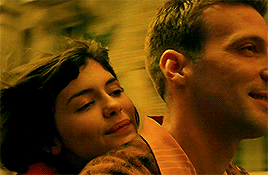
Amelie
If there was a film to define the term "whimsy" then this is it!! Its so creatively rich, with such a fun and sweet art style in the characters, the way its filmed, the music, the romance- it'll make your heart ache for days.
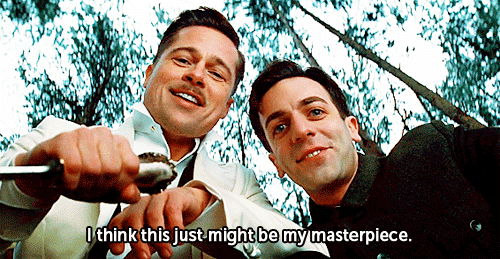
Inglorious Basterds
I'm a big whore for Tarantino ever since Reservoir Dogs, but I consider film his ABSOLUTE masterpiece. The comedically distinct characters, the sharpness of dialogue, how he builds up the tension of scenes to the point of explosion with just a simple conversation- *CHEFS KISS*
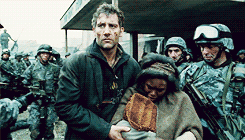
Children of Men
This dystopian sci fi drama was made in 2005 but with all the social commentary woven into the background of the story, it is eerily topical in today's tumultuous political & social climate (which is very telling about us as a society I suppose). The director Alfonso Cuaron is a master at "show don't tell" filmmaking and it SHOWS. Also the tracking long shots in this film are something to witnessed, beheld even. Masterpiece.

Bridget Jones' Diary
My absolute FAV romantic comedy, i totally relate to this bumbling, epic disaster of a woman, even more so now that i'm 30+ like her. Fun fact, the plot is heavily inspired by Pride & Prejudice which is probably why i love it so much. Also Colin Firth 🥵 (which leads me to another fun fact- he was cast as Mark Darcy mainly due to the author's crush on him from his portrayal of Mr. Darcy in the 1996 BBC miniseries which put him on the map, and rightly so. I know the film adaption is super popular, but any P&P fan NEEDS to watch this version, so so good)
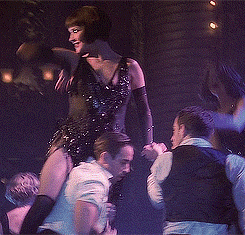
Chicago
This musical ruined all theater musicals for me forever- the film adaptation is THAT good!!! The spectacle, the numbers, the PERFORMANCES- Catherine Zeta Jones slayed as Velma Kelly (also my ovaries), i love it so much that i watched it 3 times back to back on a flight i honestly couldnt get enough lol
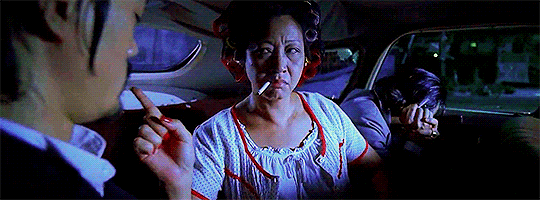
Kung Fu Hustle
This film is Stephen Chow's magnum opus- an action comedy that blends kung-fu and all sorts of historical chinese references and homages of the directors favorite films, you can tell the passion and the fun that went into making this film and it really REALLY shows. I consider this a perfect execution of what a live-action anime could be, this film is an absolute blast and classic
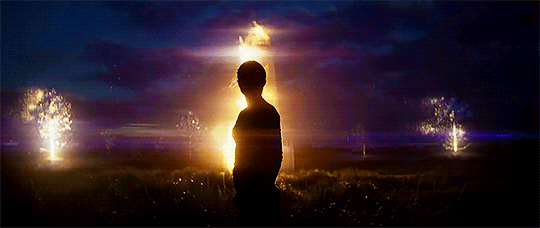
Annihilation
I've got a bit of a cosmic/existential horror kink (where a form of media makes you question the world/life as we know it or triggers an existential crisis) and this film gets it RIGHT. It's a philosophical sci-fi thriller but is so much more with its themes of pain and identity, exploration of humanity's disposition for self destruction but also its unsettling visuals and soundtrack. Funny story, the sound design is so alien/unsettling that it spooked my cat from her nap and got her staring at the screen with wide eyes and an arched back trying to figure out what the eff was going on (me as well).
Also love how its an all female cast but its never mentioned in-film; just a bunch of capable women going to take care of business (i didnt even notice until my 2nd watch)- im a fan of this approach as it in effect "normalizes" this scenario whereas calling it out as if its special just highlights how it's an exception...anyway, its a horrifically beautiful film.

Sicario
Denis Villeneuve can do no wrong in my eyes (nor cinematographer Roger Deakins), a beautifully shot thriller that serves as a social commentary on how laws are meant to be broken, lines are drawn and then erased when convenient, as long as it serves a so-called greater purpose, that keeping a moral code is a futile effort. Brilliant performed and written, nuanced characters, glorious cinematography and a killer soundtrack (RIP Johan Johansson), A+++++
alright sorry for the long rambling post, cant help myself! Tagging a bunch a folks that seem alive per my notifs, no pressure of course!!!
@writebecauseyoucannotbreathe @nuri148 @your-lavender-dreams @warbarbie @levi4mikasa @onigiri-dorkk @helena-thessaloniki @misplacedgamer @lovely-apparitions @ally147writes @stalactice @vero-icon @mylienated @hellhorsedotjpg @magicalanchordestiny
#thanks for the tag!!#tag game#robocop#atonement#amelie#inglorious basterds#children of men#bridget jones diary#chicago film#kung fu hustle#annihilation#sicario
77 notes
·
View notes
Text
Candyman Commentary - Fear of Black Poverty
I know I’m late to the game, but I recently finished watching Candyman. I viewed both the 1992 and the 2021 versions back-to-back. I want to share my thoughts on each film because they were extremely different.
1992
Take yourself back in time to the early nineties. People were wearing jorts with fanny packs… What a time to be alive. Anyways, amongst a slew of bad decisions, was Candyman, a movie that greatly exaggerated fears of low-income, Black communities. What most interesting about the film is that the directors and producers were trying to be progressive by having Black representation in the horror genre. This is evidenced in the film, as exposition on the projects, specifically Cabrini Green, is info-dumped to provide historical context and an oh-so-scary back story.
Yet, while attempting to solidify the Black presence in horror media, those who made the film purposely perpetuated stereotypes and false narratives to further the “fear” aspects. For example, a video/doc of the film’s production shows producers explicitly stating that Cabrini Green didn’t look destitute enough, so they brought in more trash to make the projects look slummy. If you think about it, how does seeing trash add scare factor? It does if what’s to fear is Black livelihood and Black environments. The film heavily relies on Cabrini Green as a character itself. In doing so, it draws on the fears of White, wealthier audiences caused by Black crime and other stereotypes of Black communities. This leaves POC viewers, like me, questioning what hyperreal world the plot of the movie is taking place in and why it was considered scary.

Additionally, Candyman himself had several socially charged aspects to him. For example, his slavery related origin story and the dynamic of a Black man chasing after a White woman prompted emotions and imagery during my viewer that brought me out of the film. In some ways the movie was very socially unacceptable, even for the early nineties. My mind called back to Emmet Till and similar themes in King Kong. I presume much of this was ignored though, seeing as how the strong, Black presence of actor Tony Todd was enough in terms of social achievement for some.

For these reasons, the movie did not scare me. It also made me question how the residents of Cabrini Green, which is a very real place, felt about such representations of their community. Additionally, Clive Barker’s original story for Candyman took place in the UK and had a major emphasis on class. It wasn’t until the film was conceptualized that race was inserted as a prominent plot device.
2021
I have less to say about this film because it was very straight forward. It was obvious that its purpose was to subvert practically all the defamatory and stereotypical misfires that its spiritual ancestor displayed. It directly supported Black creativity, empowerment, and history. Its reception may have been significantly different if it was released on it’s original timeline in 2020, at the height of the Black Lives Matter Movement.
This movie had a greater discussion about gentrification and continuous violence against Black people. It did a great job of showcasing Black family and wealth, despite most people not associating the two. It also sparked an interesting conversation around Black artistry and how it can go beyond focusing solely on Black trauma. Instead of having most of the scare factor lie in Black poverty, the film chose a more relatable, loss of self/identity. Psychological thrillers are scary for everyone, regardless of one’s background or biases.

Final Thoughts
I believe the newer film succeeded where the original did not. However, neither film did much for me. I think I’m just not a fan of the Candyman story in general. It’s much more of a revenge movie than a horror for me. I also don’t enjoy summoning rituals being such a key plot device of a horror film, rather than the typical one and done and the plot progresses. Guess I’m just not into Candyman but, I’m sure he’s living in the hearts-and mirrors-of his biggest fans.
#candy#man#candyman#monkey#paw#monkeypaw#jordan#peele#jordan peele#horror#Black#race#race and ethnicity#gentrification#project#projects#thriller#movie#film
4 notes
·
View notes
Text
an anecdote in regards to the discussion in that gentrification discussion
gentrification and the role of various involved parties was a common theme in several courses during my education that focuses on arts & culture. one time i had a class where you were encouraged to discuss your own role in gentrification in the city. i hadn't read the article for that day fully which was a big mistake.
one girl (yes, that goth one i had beef with 🙄) said she is a gentrifier bc she doesn't like how her street looks and was openly very disgusted by living near an islamic butcher. i told her off bc that was so insulting and the turkish girl near her looked visibly uncomfortable / shocked. to try to show you don't have to be like her nor should be proud in wanting to enforce your elitist and racist view on what a nice neighbourhood is, i said i don't want that to happen to where i live as my view has nothing to do w how neighbours like to live and that there is nothing wrong or 'ugly' abt a neighbourhood w mixed cultural backgrounds.
i then tried to argue that i'm not partaking in gentrification bc i'm in the same economic class as my neighbours in the street and don't want to change the buildings and whatnot.
that last argument was not great and was definitely made while not understanding the class material fully, as my teacher asked me smth akin to 'so you think you are not a gentrifier because you are also working class? so you aren't a gentrifier because you can't or don't want to change the whole area? i don't think you understood the material well.' and asked the class to explain.
basically, the rest of the class told me that gentrification is not just the act of physically changing an area with creative businesses or consciously and physically changing the homes and whole population, but also wanting to do it, and by solely moving in there as a white resident, contributing to gentrification. all in all i learned not to speak on articles i didn't get or equate my position to that of POC in the working class who do not get the same opportunities.
2 notes
·
View notes
Text
Rationale
When gentrification is executed under the name of regeneration and class differences are at the forefront of unintegrated communities, this piece presents how the effects of rich stakeholders’ choices -centred around the neighbouring middle class needs for tasteful surrounding caused a horrific end to life for many members of the Moroccan community. This, known as the tragic Grenfell tower fire of 2017, saw the rise and saddening fall of the largest Moroccan community settlement in London. By using Grenfell tower to illuminate an untold livelihood (Weintraub, 2003), this piece aims to perceive the ways in which the Moroccan community’s unjust experienced realties of the UK ‘promised land’ contradicted their hopeful expectations to build a prosperous little British Morocco. Through an overarching seldom exploration of Moroccan migration and settlement within the UK, this piece encapsulates themes surrounding Moroccan identity construction, injustice, inequality and social neglect within a time of welfare cuts and the increasingly growing gap between rich and poor. I present this piece as a commemoration of rich Moroccan culture that would have successfully prospered if had been untouched by systematic inequalities which saw the Moroccan community the denial of “cultural and profit in all their forms” (Bourdieu, 1986, p. 241).
The birdcage instillation is a metaphorical presentation of the Grenfell structure which illustrate notions of entrapment and isolation of the Moroccan community, but also serves the juxtaposition of the cage previously acting as a form of refuge. By locating this piece amongst MENA artists such as Amina Benbouchta, whose conceptualisation of cages depicts seldomly discussed social issues, I am influenced by the symbolisms around birdcages. One of which enables the communication of unhealthy realities to the audience through which is inside the cage. The burnt uprooted tree trunk that represents a sudden death of Moroccan livelihood, that in conjunction with the colourful Moroccan cultural screen-printed images which personifies the Moroccan communities’ innocently preconceived expectations of the UK, communicates the saddening reality of an abrupt ending to an already deprived growth of community. Red and green wool which indicates the Moroccan flag interconnects up and around the bars of the cage holistically deriving from the Moroccan screen-prints. The wrapped wool as if steady growth of ivy, further communicates the reality of the sudden halt in progression as it’s met with black wool that represents the burnt upper section of Grenfell tower. The photoshop edited backdrop of smoke reveals images of social issues that the government concealed and failed to address. This further facilitating the deprivation of growth within the Moroccan community which remains a neglected and an untold reality. However, this piece presents some elements of hope as growth of colourful roots which managed to survive descends through the bottom of the cage. Through unpredictable and unfixed lines of possibilities of roots (Deleuze and Guattari 1987), the enablement of some growth towards success within the Moroccan community is displayed. A small victory that celebrates Moroccan culture through its vibrant nature of the roots is aimed to motivate the remaining British Moroccans to continue the momentum of those who died trying to grow towards places of security, freedom and success.
This cage hangs low for audiences to view the details within the screen-printed Moroccan imagery, but high enough to outcast this piece. A hand constructed from a Union Jack screen-print holds the cage at a controlled line of sight to symbolise how the government continues to have control through their neglect in taking responsibility for the Grenfell tragedy. The cage spins theatrically to dispense a concentrated view of the screen-prints, whilst simultaneously expressing how the stark multifaceted notions of inequalities and injustices remain untreated by the government. Therefore, the notions embedded within the cage continue to spin into the realities of those from vulnerable and BAME backgrounds.
1 note
·
View note
Link
Twelve years, two books, and one Kickstarter-funded movie later, one of TV’s greatest shows has made its triumphant return. Veronica Mars season 4 is just what Marshmallows around the world have been waiting for.
It’s hard to believe that a Veronica Mars season 4 exists, let alone that it has been twelve years since we all first thought we were saying goodbye forever to one of the wittiest, smartest, and most heartfelt shows to have ever been created. Who would have ever thought that a show that struggled to stay on the air as long as it did would have had such a well-deserved comeback?
I, for one, never imagined it. The hope of a small reunion, a one-off, was a glimmer on the horizon for the longest time. And then the announcement of the Veronica Mars movie came and it seemed like we hit peak-Veronica Mars revival culture. But then came the books. And the whispers of a new season.
But with every shiny new Veronica Mars property that came out, the question of “Could it possibly be as good as the original series?” always lingered in the background. Especially with this new season.
‘Veronica Mars’ season 4 review
Suffice it to say that Hulu’s Veronica Mars season 4 revival combines everything you love about the original run of the show with everything you enjoy about binge-worthy television. Updated to reflect the current world climate and to fit into the true crime era we’re now living in, this new season of Veronica Mars feels exactly like how you think a modern run of the show should.
Veronica Mars season 4 picks up not too long after the events of the movie, so a few years at most. Veronica and Keith Mars are working cases side by side, struggling as ever to keep business afloat. Though Veronica’s takedown of Bonnie DeVille’s murderer shone a bit of a light on Mars Investigations, business isn’t really booming. That is until a serial bomber threatens the lives of numerous young people and, even worse, the livelihood of Neptune: Spring Break.
Pooling their resources, connections, and keen instincts for detecting mischief and wrong-doing, Veronica and Keith set out to unmask the bomber before any more lives are lost and the 09ers achieve the return to the “idyllic” and clean (read “white” and “privileged”) Neptune they’ve been fighting so hard for.
There’s quite a lot going on in Veronica Mars season 4. So much so that it doesn’t waste any time jumping in to the conflicts or adding in any gratuitous (Marshmallow) fluff. In fact, this is probably the property’s leanest bit of storytelling as practically every scene and encounter serves a purpose in driving characterization or one of the two main plots (the bombings and the excess gentrification). Though they were also focused on one or two main plots, as well as character development, the movie and the books didn’t feel nearly this streamlined.
That could partially be due to the immense fan service those three bits of storytelling felt compelled to do. While the movie and the books trotted out fan-favorite character after fan-favorite character, there’s quite a bit less of that in this new season of Veronica Mars. While there are some beloved characters that make appearances from time to time, there are fewer of them and they’re not around as much as you’d expect.
In fact, there are perhaps more cameos that feel like they’ve come out of left field than there are appearances by some of the more well-known supporting cast. Without revealing anything, I’d say it’s important going into this season without high expectations of seeing a lot of your favorite supporting characters (if they even show up at all). Their absence is jarring at first, but, once the story gets going, it’s clear that they just don’t fit in well with the current story and shoehorning them in as fan-service just wouldn’t work.
Honestly, Veronica Mars season 4 is less about fan service and more focused on getting back into the groove of the show. Like the series’ original run, this new Hulu season is the perfect mix of darkness, laugh-out-loud comedy, and heartfelt moments. Veronica’s personal mantra that “the people you care about most will always inevitably let you down,” while not as prevalent, still very much lives in the shadows of every interaction she has and relationship she develops.
That being said, while it does work hard to return back to the show’s roots, this season isn’t an exact return to its original form. Given just how much time has passed since the show went off the air and how different the world is today, there’s no way it could be. For all of the way it emulates and pays homage to what has come before, this revival season demonstrates just how much the show, as well as the characters, has evolved.
There’s no better example of this evolution than by tracking all of the different iterations of the show’s theme song, “We Used to Be Friends.” It first changed in the show’s third season, after Veronica Mars‘s move to The CW where the story arcs and overall season structure, not to mention the setting, shifted. The Veronica Mars movie then introduced a more stripped-down and slightly upbeat version which matched the film’s fan-service/reunion vibe.
Now, in this revival season on Hulu, the theme shifts again, this time to a more haunting, ethereal, and noir-ish rendition by Chrissie Hynde of The Pretenders. It takes an episode or so to get acclimated to (after all, the original theme is a classic), but it perfectly conveys just how much Veronica and the show have grown in the past fifteen(!) years. It’s sophisticated and dark yet still playful, just like this season. And it matches the stunning new opening credits perfectly.
Another example of the show’s evolution, as well as its return to form, is Keith and Veronica’s relationship in this new season. They may not have seen eye to eye on Veronica’s decision to stay in Neptune and officially join the family business, that storm cloud that hovered over their relationship in the movie has since dissipated. It’s clear that Keith still doesn’t agree with Veronica giving up her fast-paced lawyer life in New York, but he respects her decision. He makes one remark to his daughter about joining a law firm but ultimately drops the argument.
The show is all the better for this. The moments between Keith and Veronica are some of the best of the season, if not the entire series. They’re just as witty and sharp when interacting with each other, and yet there’s a more mature tenderness that has developed between them since we last visited Neptune, thanks in large part to the fact that they’re now equal business partners. Their relationship isn’t too mature, however, to not have at least one “Who’s your daddy?” quip!
Oh, and there’s a hilarious “cuss war” between Keith and Veronica that’s introduced in the first episode and runs throughout the duration of the season. Presumably, it’s a direct reference to Kristen Bell’s role as Eleanor on The Good Place, but, while it’s an allusion to the NBC show, it fits perfectly here. It’ll seriously have you laughing out loud every time it comes up.
For all of its similarities and callbacks to the previous seasons and stories, there are some pretty drastic differences between Veronica Mars season 4 and its predecessors.
Perhaps the most notable difference this season is the lack of “cases of the week.” Personally, I’m a huge fan of the “case of the week” structure because it’s a fun way to test our characters and reveal different facets about their personalities and relationships with one another. The cases also usually give the overarching mysteries and storylines space to breathe so that when those reveals do come, there’s no emphasis lost.
Additionally, these mostly self-contained mysteries provide a helpful background in distinguishing between episodes. As is so often the case with shows that are meant to be binge-watched, the episodes in Veronica Mars season 4 all run together and don’t have all that much to distinguish themselves from one another. It’s honestly hard to recall which episodes I enjoyed the most out of this season because the entire thing is a blur.
Though I do think there’s a bit of the Veronica Mars charm and cleverness that’s lost without the inclusion of smaller cases, there just wouldn’t be any room for them here with the way the season is plotted out. After all, it’s doubtful that Veronica or Keith would even dream about taking on additional cases after fully entrenching themselves in the case of the spring break bomber.
That’s not to say that there isn’t a lot packed into every episode of Veronica Mars season 4. Each episode is at least 50 minutes long, which means that, even though this Hulu revival season has a total of eight episodes, it’s almost like we’re getting nine and a half episodes worth of classic Veronica Mars (or about four movies).
It’s hard to determine whether or not the amount of episodes we get this season is optimal or not. On one hand, there’s just the right balance between effective character moments and plot. But on the other, this season’s plotlines don’t land quite as hard as past ones, at least on first watch.
The most drastic difference between Veronica Mars season 4 and the rest of the series is the fact that Veronica has less of a personal connection to the overarching mystery this time. Sure, she puts herself in the middle of everything and the bombings impact her daily life. But she takes the case because it’s the right thing to do, not because she or someone she cares about has been directly affected by the bombings.
Her lack of attachment slightly lowers the stakes for the season, which is kind of disappointing that the season focuses solely on the one mystery. Yes, people are being murdered by explosive devices. My observation here isn’t meant to make light of that. But, because Veronica’s personal stakes are generally lower throughout the season, the impact of the mystery is lessened considerably and the “whodunnit” just feels less pressing than usual.
Veronica Mars season 4 also deviates from the norm in its commentary on class and privilege. The plotline about the 09ers working to re-gentrify Neptune and drive out the “riff raff” (including the yearly spring breakers) is an underlying current, but it focuses more on how selfish the “haves” are rather than the impact all of this has on the “have nots.”
Though the movie indicated that a pretty big class war was on the horizon, that tense atmosphere seemingly evaporated in the time since Deputy Sacks was murdered in that “car accident,” most likely due to the sheriff’s department actually being not that corrupt this time around (which is a pretty big shocker).
It’s a small difference that perhaps I’m being too picky about, but after the movie did a great job discussing the racial inequality in Neptune and setting up the town itself as a bomb that was about to explode, the discussions in this new revival season are anti-climatic at best.
And then there are two side plotlines, one involving a senator and the other a Mexican cartel, that just don’t mesh well with the rest of the season at all. They’re directly connected the bomb and 09er plots, but really serve as nothing more than a distraction from everything else that’s going on. Yes, they (sort of) play their part in the season’s climax but are otherwise equal parts pointless and frustrating.
That all being said, the bombing storyline is definitely captivating from start to finish (and then some). The threat this season is no joke as the explosions come without warning and in crowded areas. The bomb that detonates in 4×04 is particularly gruesome and hard to watch, especially in the immediate aftermath. Not only that, but they’re hard to track. Many times, mysteries can be pretty easy to figure out but, true to form and thanks to a few pretty big twists, this Veronica Mars mystery will keep you guessing and feel like you’re missing something until the very end.
New to this season, Patton Oswalt’s pizza delivery guy character introduces a “true crime” element into the Veronica Mars universe which, honestly, I can’t believe we haven’t seen before. He follows all of the bombings going on, as well as the other cases Mars Investigations has taken on in the past, and adds a layer of skepticism. Not only that, but he also serves as a way of legitimizing just how intelligent Veronica is and how perfect she is in the role of a private eye, rather than a lawyer.
In this era of true crime that we’re all living in, it’s easy to forget that there are real people involved in the crimes and real lives at stake. While it’s not an official plotline for the season, one of the effective underlying currents is the slow takedown of true crime enthusiasts and just how much harder it is to solve crimes in real time and in the field rather than from a couch or a cell phone.
Speaking of characters with notable storylines, what would an article about Veronica Mars be without fangirling a bit over Logan Echolls and LoVe? After everything he has experienced in his life (especially the last few years), it makes sense that Logan we meet in Veronica Mars season 4 is quite different from the Logans we knew in previous seasons. Still a United State Naval Aviator, this Logan is regimented and reserved. He’s still witty and charming, but in a more subtle way.
However, Jason Dohring and Kristen Bell’s chemistry is still as sizzling as ever. Each scene they share is incredibly nuanced and emotional. Logan and Veronica may say one thing or act one way to each other, but their body language and facial expressions many times tell completely different stories. And yet, there’s still a sense that these two are not only completely meant for each other, but also that they’ll figure out some way to make it work.
This season takes extra care with Logan’s character, fleshing him out and bringing us all up to speed with just who he is at his point in his life. No longer surrounded in controversy, we’re able to see Logan the man rather than the Logan who’s almost always at the center of a storm. Not only that, but this season gives us a better understanding of who Logan is outside of his relationship with Veronica (or really, any other regular characters from the show). We get to see Logan for Logan. Jason Dohring gives his best performance as Logan in this season and, honestly, he’s a joy to watch.
And then there’s Veronica.
Veronica Mars is no longer the brooding teen and town pariah she once was. She’s all grown up now. Of course, Veronica still has her flaws (mainly her penchant for distrusting just about everyone and her unyielding pride), but she knows who she is and accepts all of the aspects of herself, for better or worse. This Veronica is self-aware enough to know when she’s in the wrong and she’s getting better about owning up and apologizing for it.
Also, although she tries to put up the same sharp, prickly front, it becomes increasingly apparent through the season that Veronica has softened considerably. Sure, she still just as witty and clever as she always was, but her second chance at love with Logan as well as her father’s brush with death has made her more of a marshmallow than she was before. Veronica wears more of her emotions on her sleeve and isn’t as quick to dismiss others as she has been in the past. In fact, dare I say, she’s more trusting and lets people in a lot more than she used to.
Veronica’s character development from the movie to now and all throughout this season is incredibly gratifying to watch. Following her trajectory has been a bit of a frustrating struggle sometimes, but this season makes it all worth it.
Veronica Mars season 4 has been a long time coming and, now that it’s finally here, it’s hard not to love it. This season is by no means perfect, but it feels like a proper return to Neptune and all of the characters we Marshmallows care so much about. Plus, it’s quite an enjoyable and emotional ride from start to finish with some pretty big twists and major events along the way (two in particular that will most likely set the internet ablaze).
Fans of Veronica Mars as a whole won’t be able to get enough of this fresh take on the show and will surely be clamoring for more as the final episode’s credits roll.
Random spoiler-free notes from watching ‘Veronica Mars’ season 4
The first episode makes it feel like truly no time has passed since the show went off the air. It sets up all of the season’s conflicts and storylines as effectively as its 1×01 and 2×01 predecessors.
OMG DICK.
I’ve never been more turned on by a Frank Sinatra song since 10 Things I Hate About You.
Wait, is this show actually introducing capable semi-capable local law enforcement with a sheriff that isn’t completely self-involved?
So Logan is effectively Veronica Mars‘s version of the Bruce Banner?
This season is very Jessica Jones-like in its story-telling. There are no “cases of the week,” but there is a lot of sardonic commentary to go around.
OMG THE BOOKS ARE OFFICIALLY CANON!
Is this show introducing a “new generation” here or something? Could you ever have Veronica Mars without Veronica Mars?
‘Veronica Mars’ season 4 will be streaming exclusively on Hulu starting Friday, July 26, 2019.
8 notes
·
View notes
Text

I posted 2,111 times in 2022
242 posts created (11%)
1,869 posts reblogged (89%)
Blogs I reblogged the most:
@casgirl
@downahill
@dogmotifs
@saintcarrie
@legalizegrank
I tagged 759 of my posts in 2022
#riverdale - 88 posts
#spn - 86 posts
#succession - 85 posts
#black sails - 41 posts
#twin peaks - 41 posts
#our flag means death - 39 posts
#hacks - 30 posts
#house of the dragon - 25 posts
#stranger things - 21 posts
#euphoria - 19 posts
Longest Tag: 140 characters
#it's like background noise stress that rn someone is sitting down and reading thee experimental comedy for the ages titled no entrance......
My Top Posts in 2022:
#5
it’s actually so powerful that riverdale started with like the gang does child labor and then gets to a place of the cast singing “bread and roses” and having pro-union plot lines….it’s cinema
20 notes - Posted November 15, 2022
#4
but also riverdale is so good in season two the way it traces how white masculinity, unaddressed trauma, and the availability of guns combine to become the fuel for rhetoric about “safe” communities, gentrification, and policing that instead of impacting the white and wealthy perpetrators of violence — the clifford blossoms or hal coopers — devastates the lives of the serpents, who are poorer and often people of color.
& the fact that this is also the season that introduces jingle jangle, gryphons & gargoyles, and the seasonal riverdale musical episode??? it’s a camp classic with BRAINS with MESSAGES with POWERFUL TOPICAL THEMES!!!!!!!!!!
21 notes - Posted November 19, 2022
#3
when steide makes blackbeard’s piece of silk from his childhood into a pocket square in the moonlight......jaws dropped hearts exploded people died
35 notes - Posted March 25, 2022
#2
“the chain” needle drop........”you came back” “I never left”............laying on the ground looking at each other the whole time they got captured............like YEAH..........OUR FLAG MEANS DEATH IS EVERYTHING..........INVENTED CINEMA AND TELEVISION
36 notes - Posted March 25, 2022
My #1 post of 2022
also so iconic that season one of black sails was just flint waking up every day of 1715 being a cunt causing problems making cryptic statements about his past and having bad sex with miranda. THAT is how you introduce a main character
2,419 notes - Posted February 17, 2022
Get your Tumblr 2022 Year in Review →
#tumblr2022#year in review#my 2022 tumblr year in review#your tumblr year in review#honestly? fascinating data
1 note
·
View note